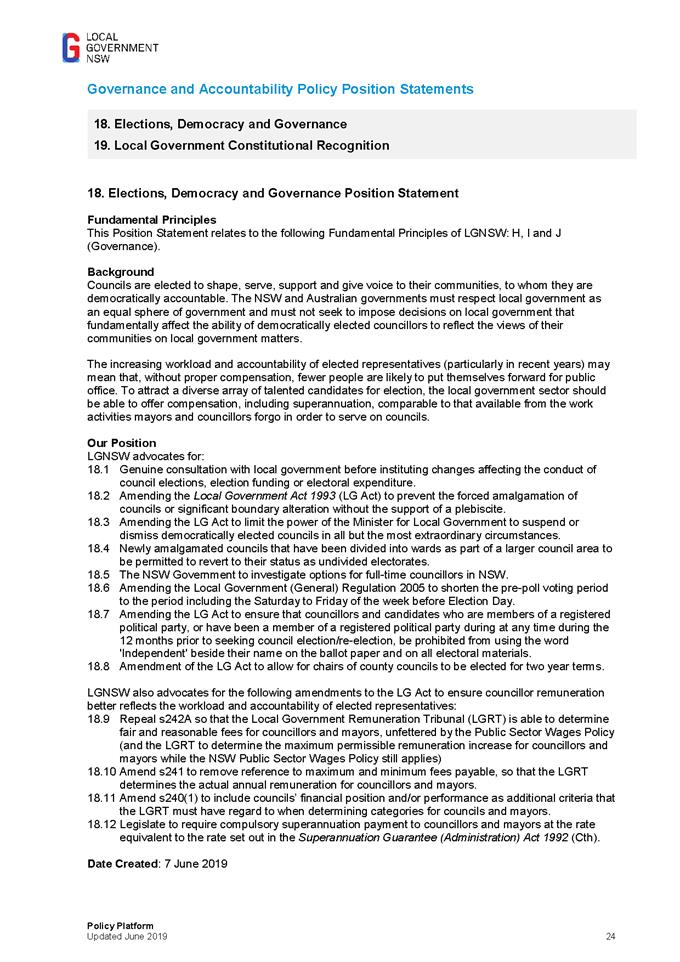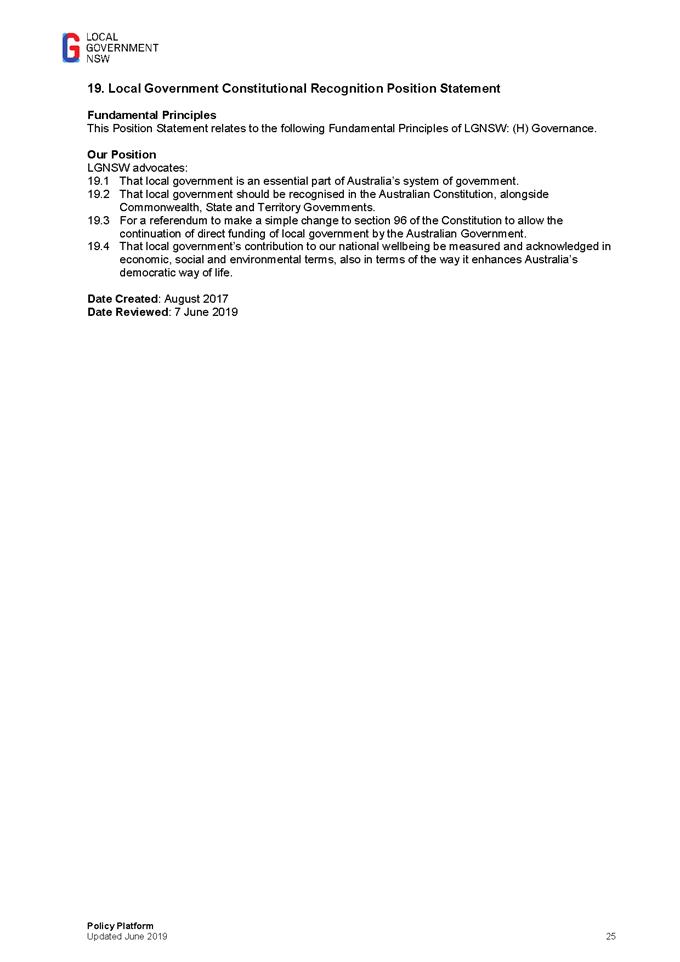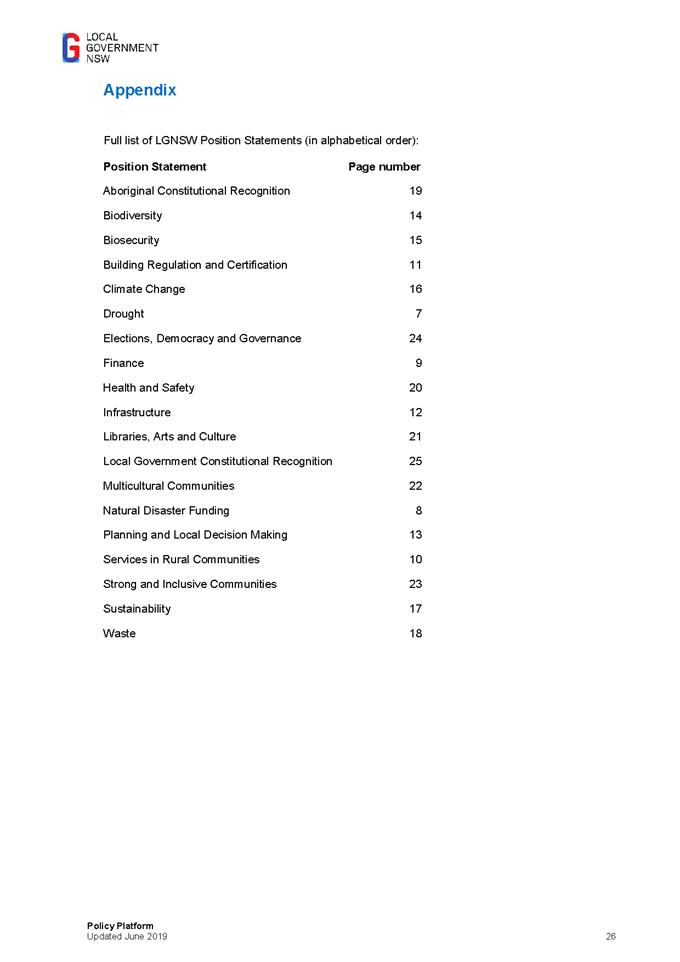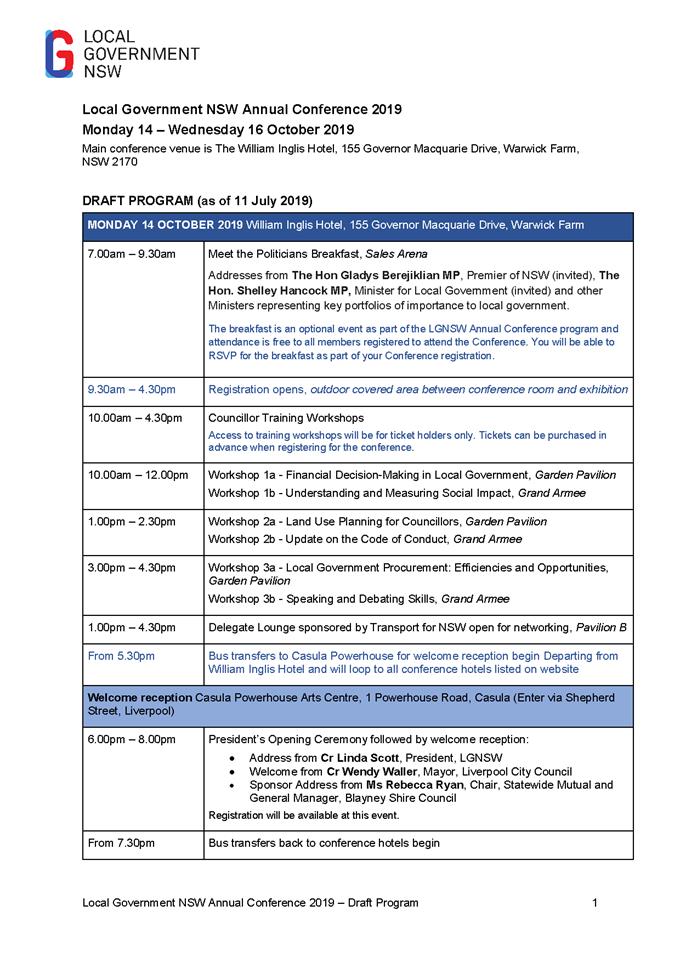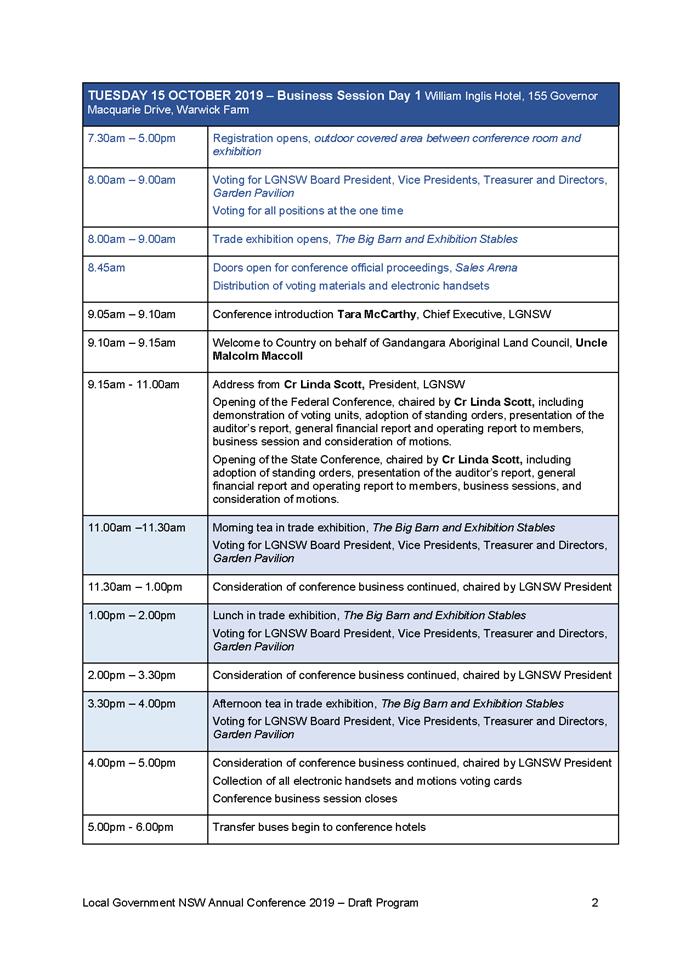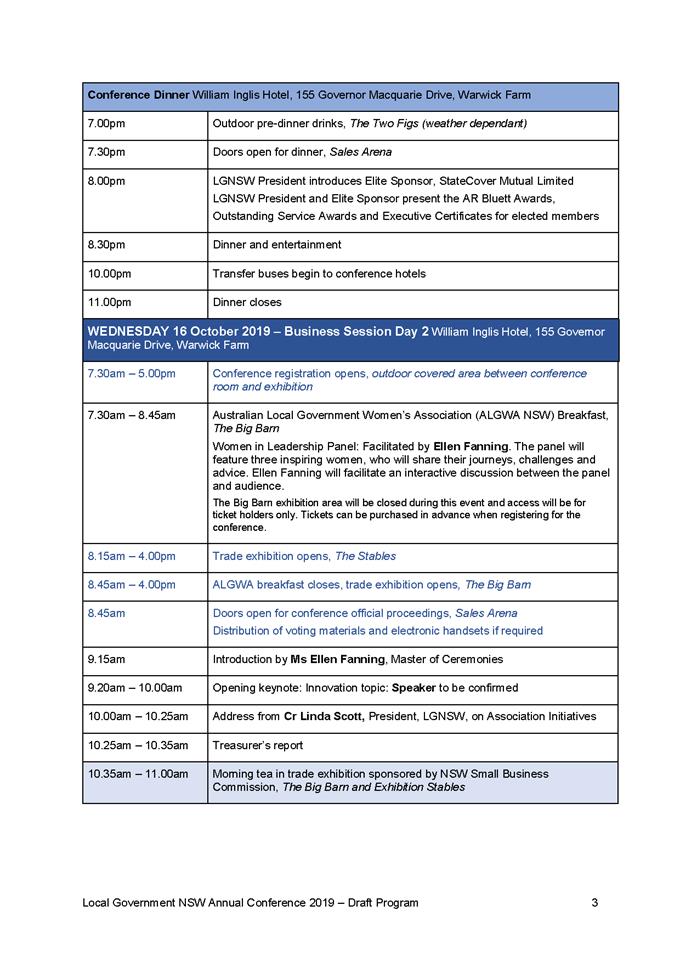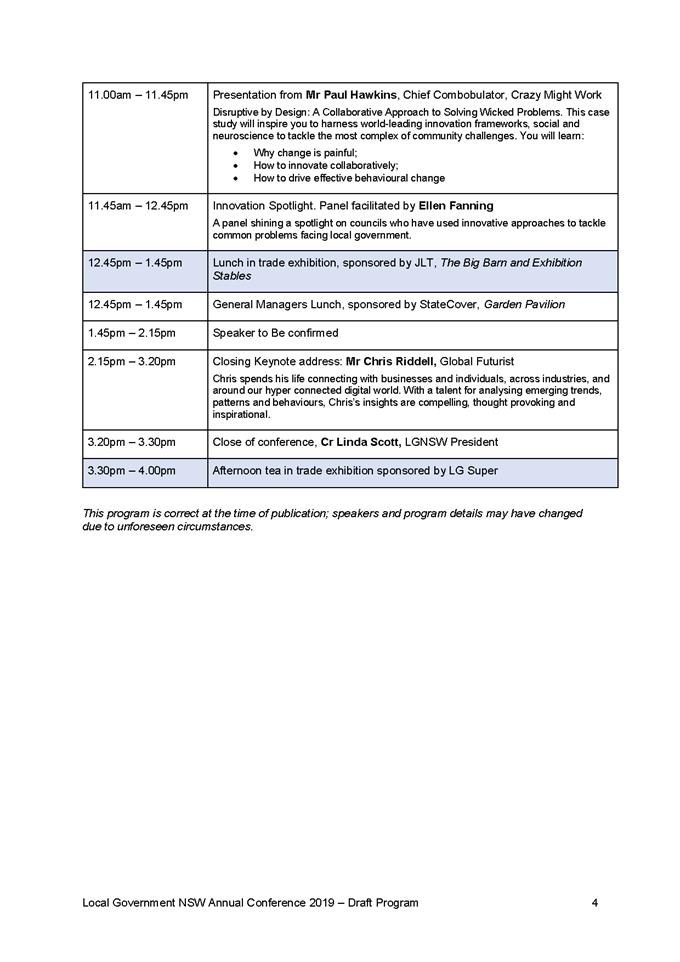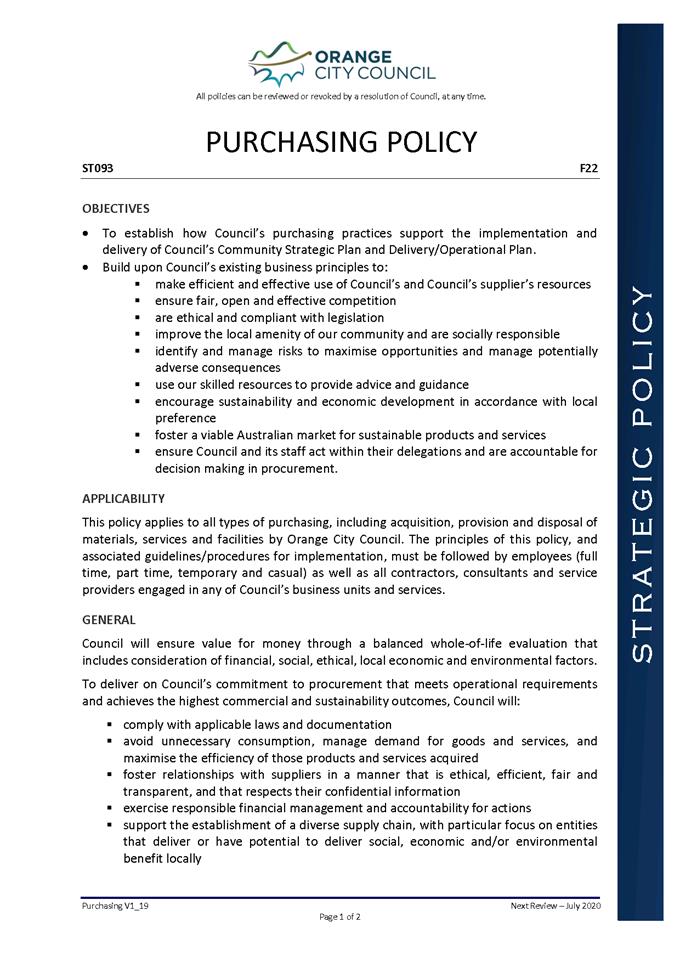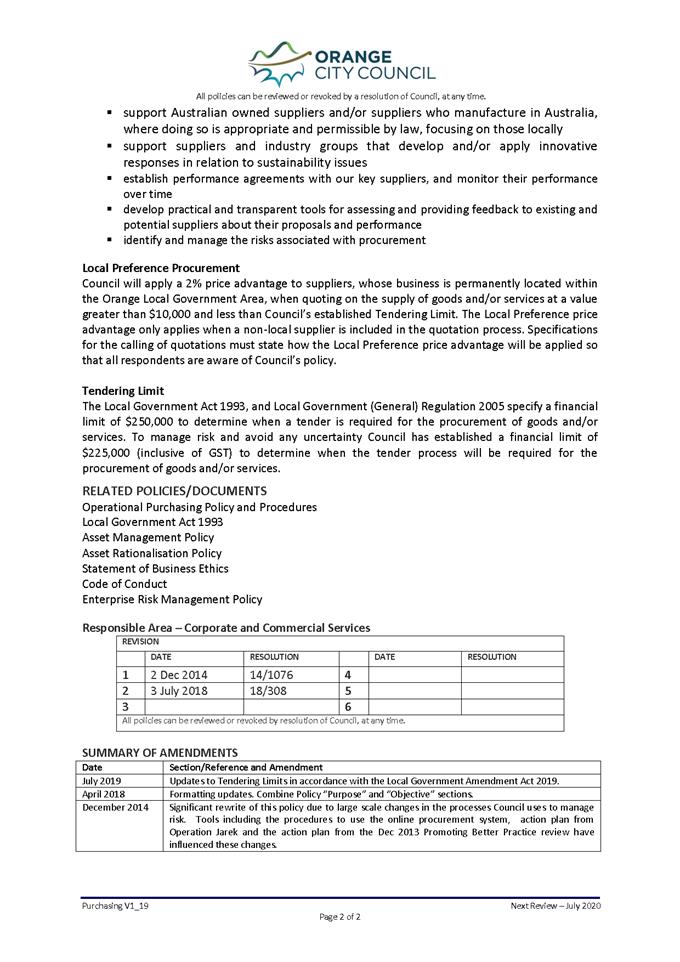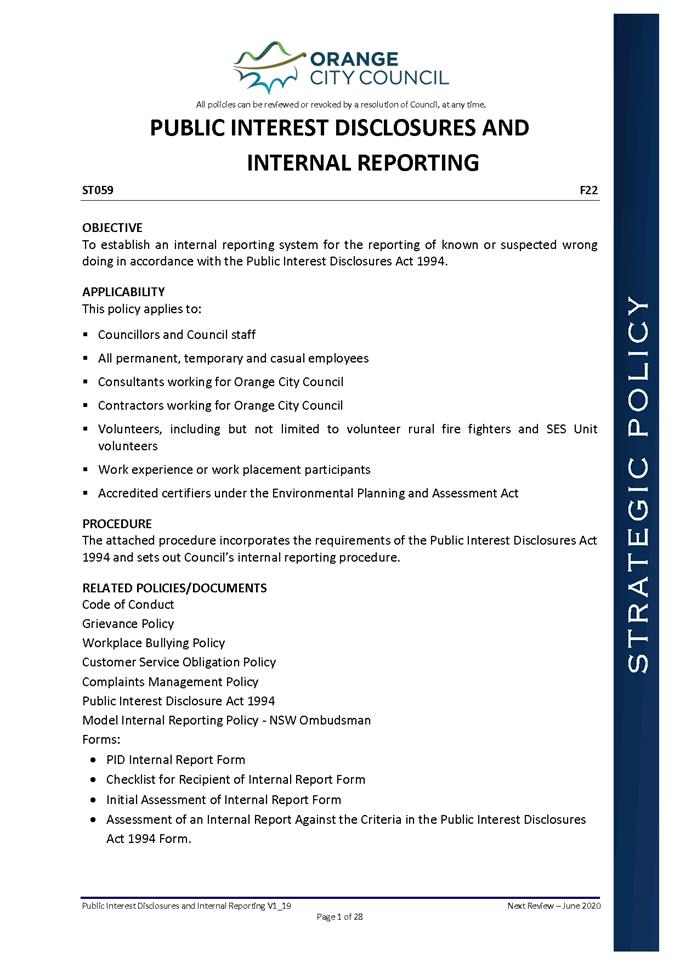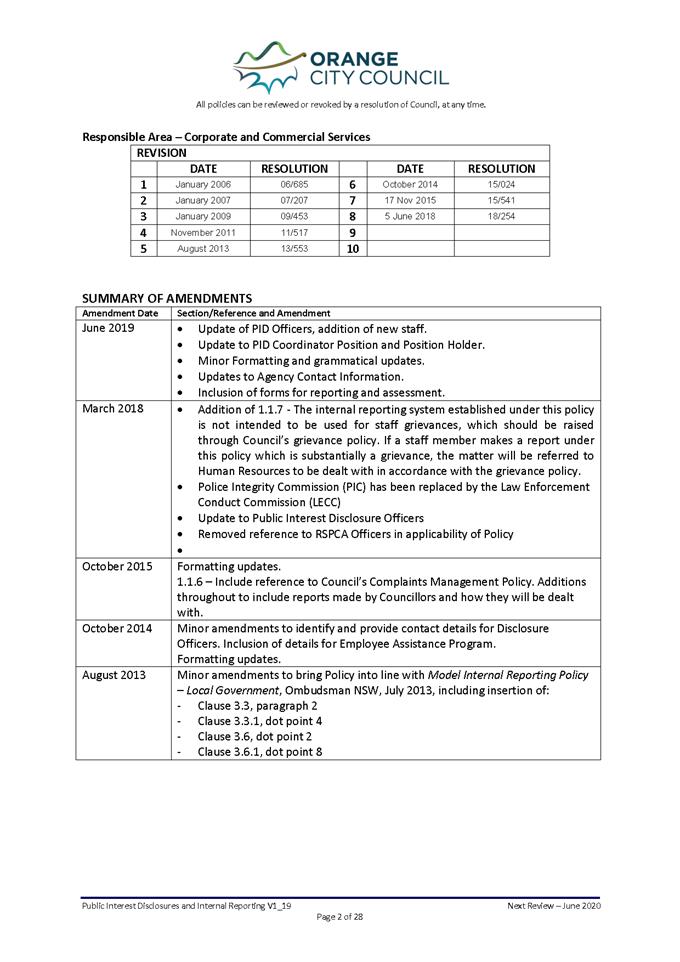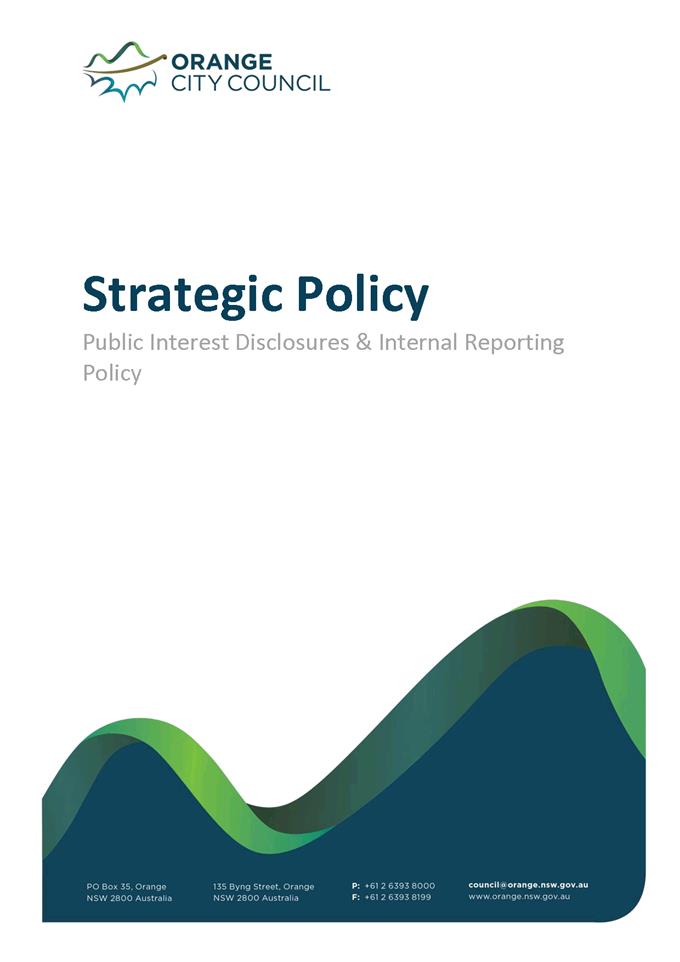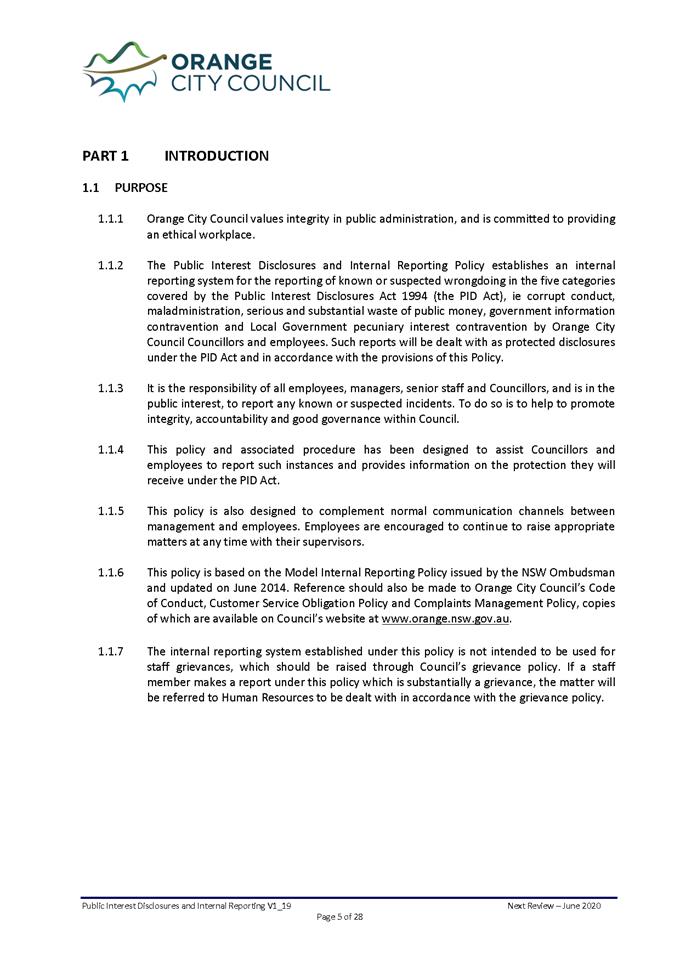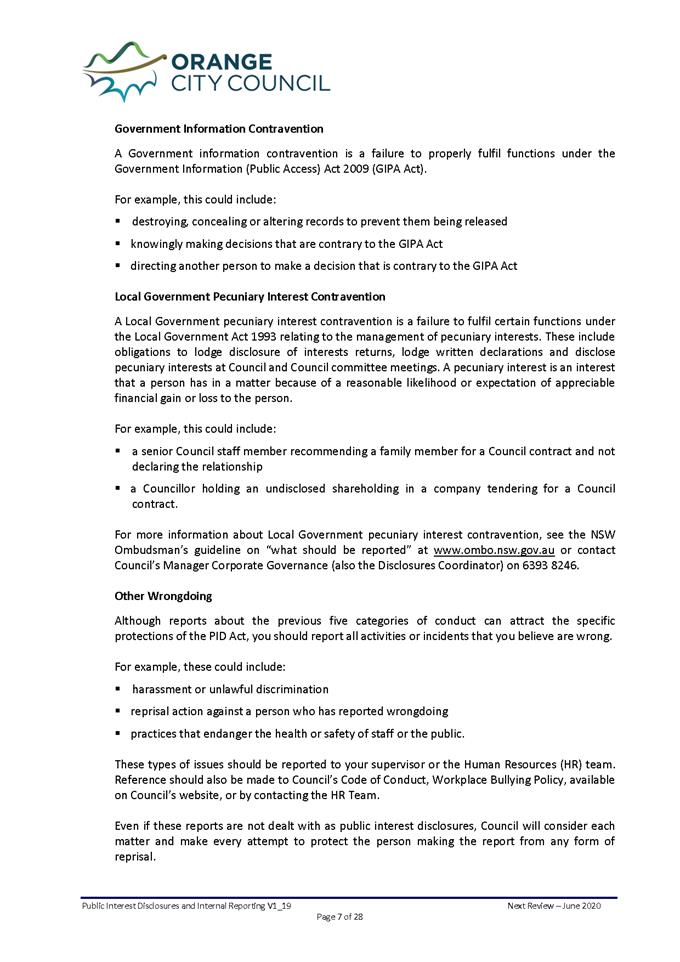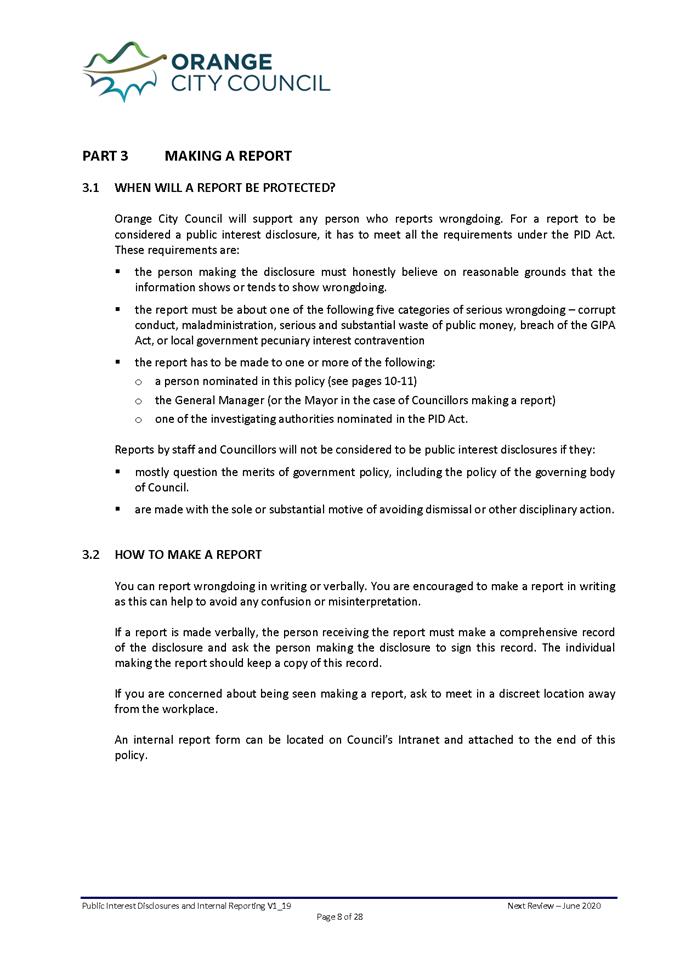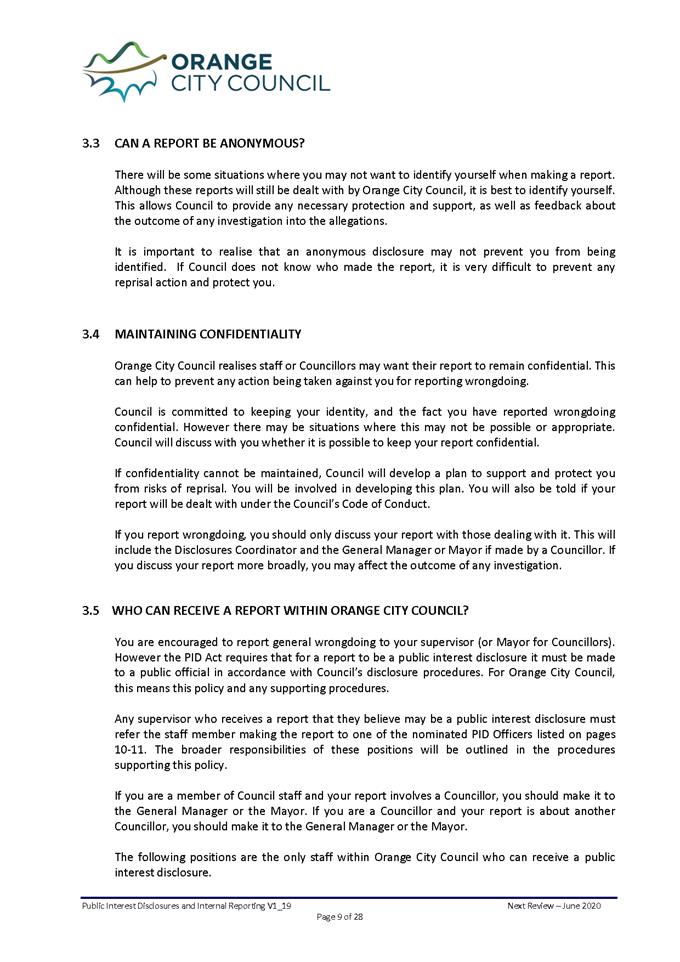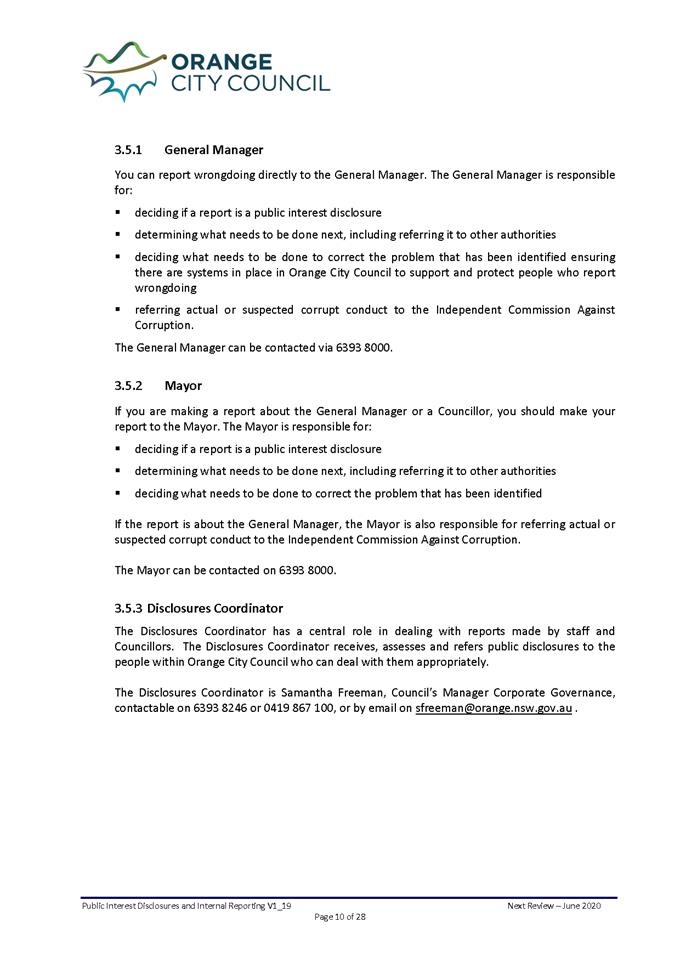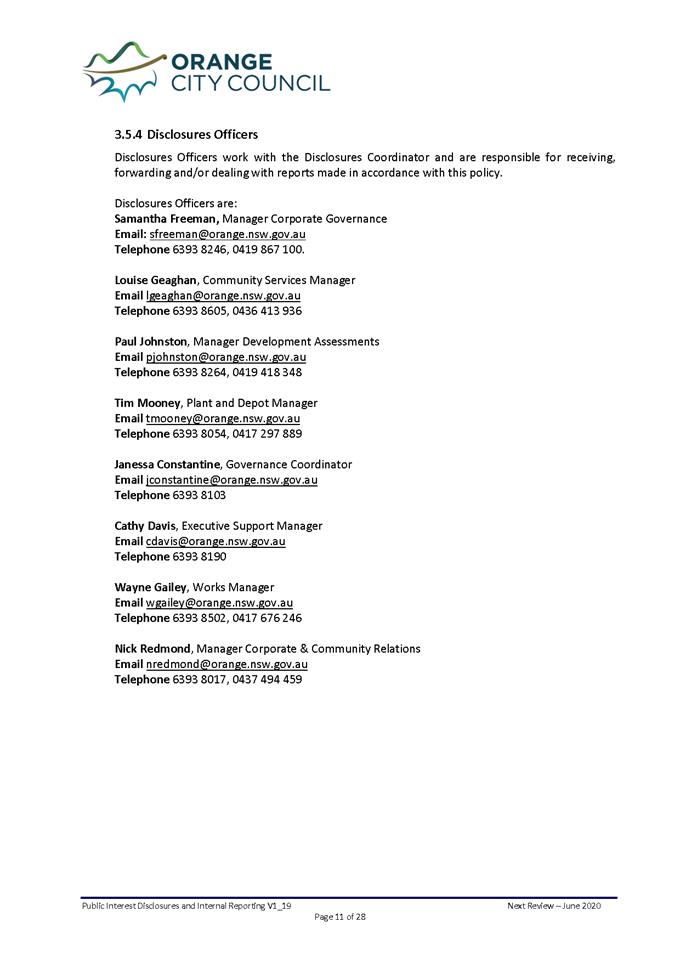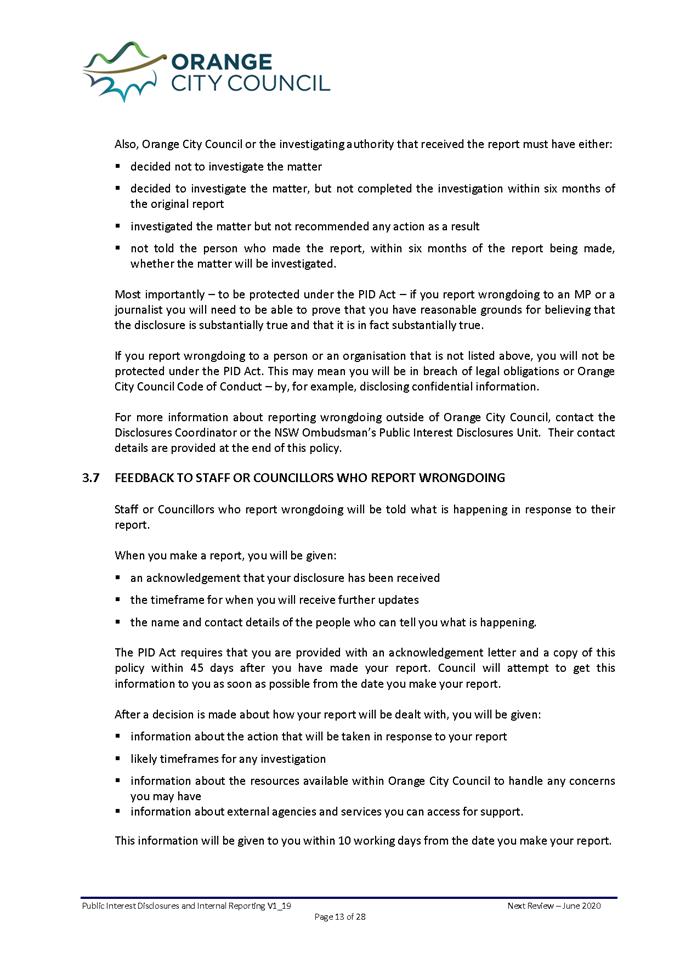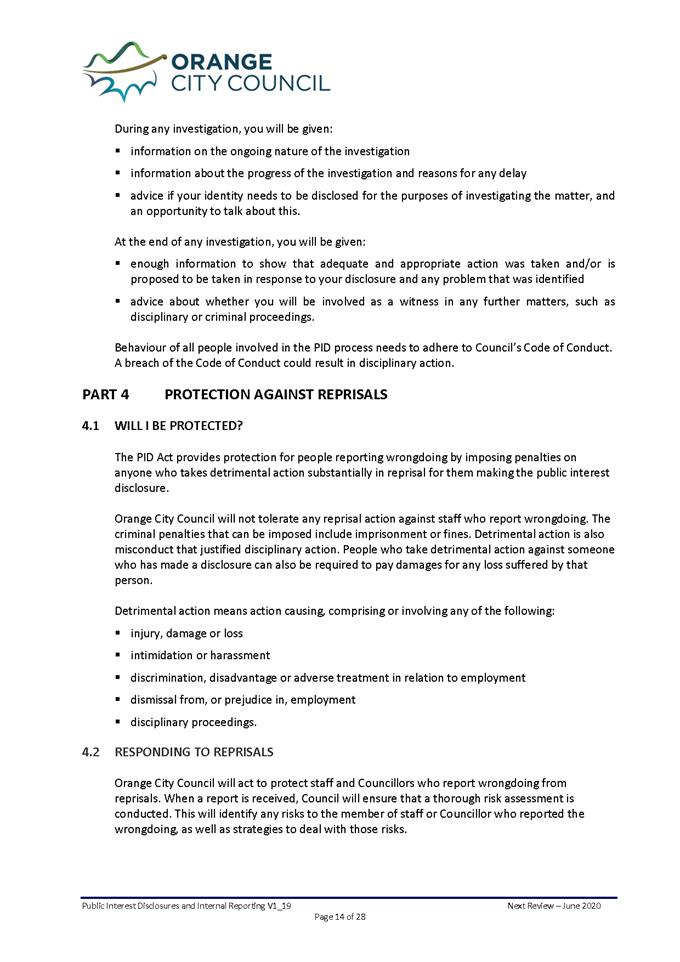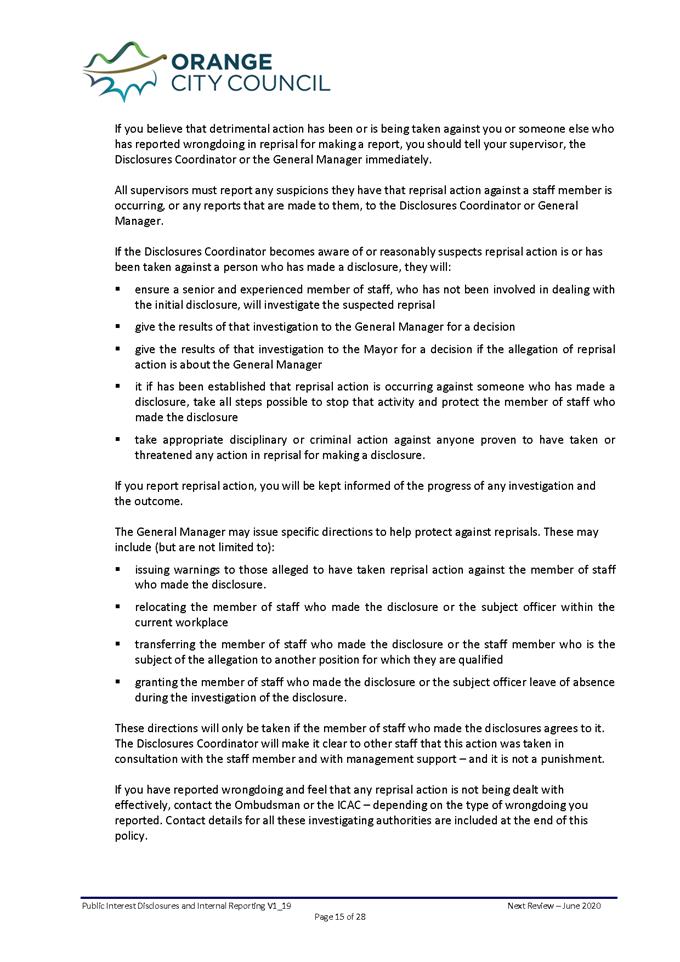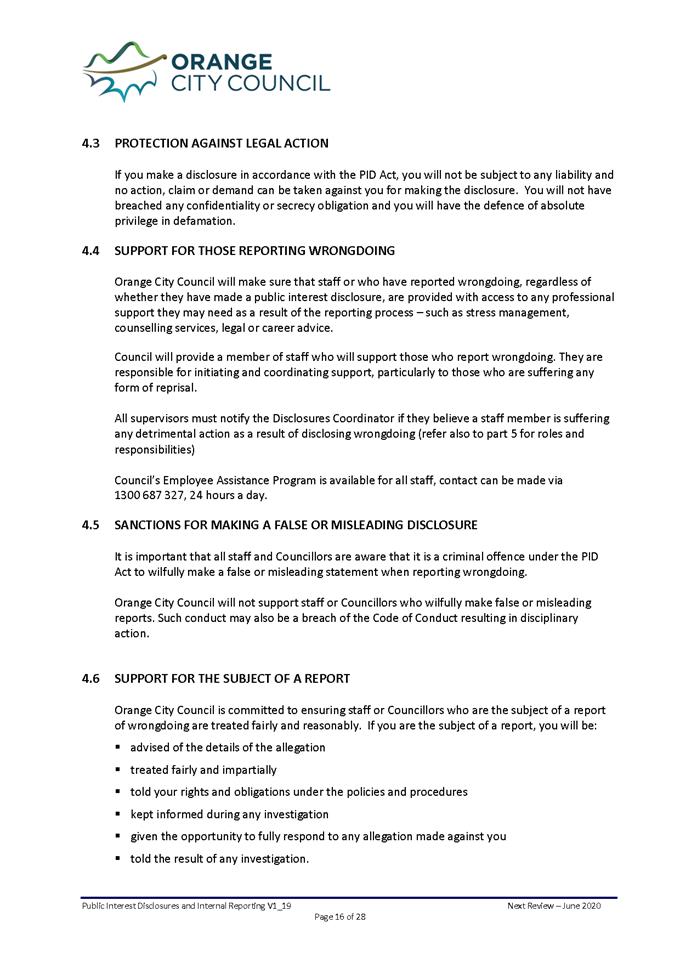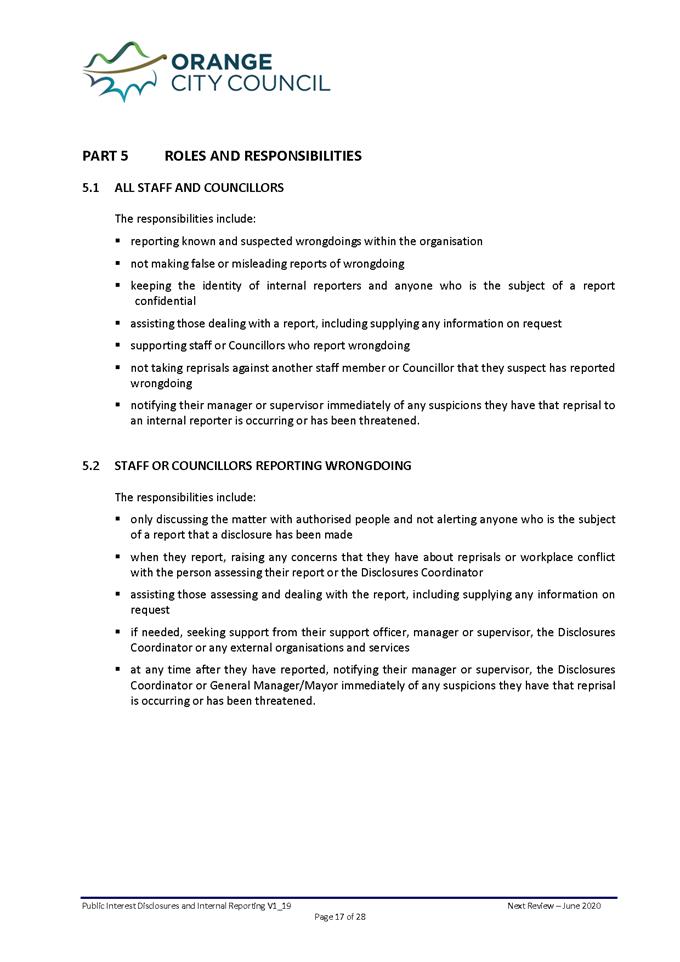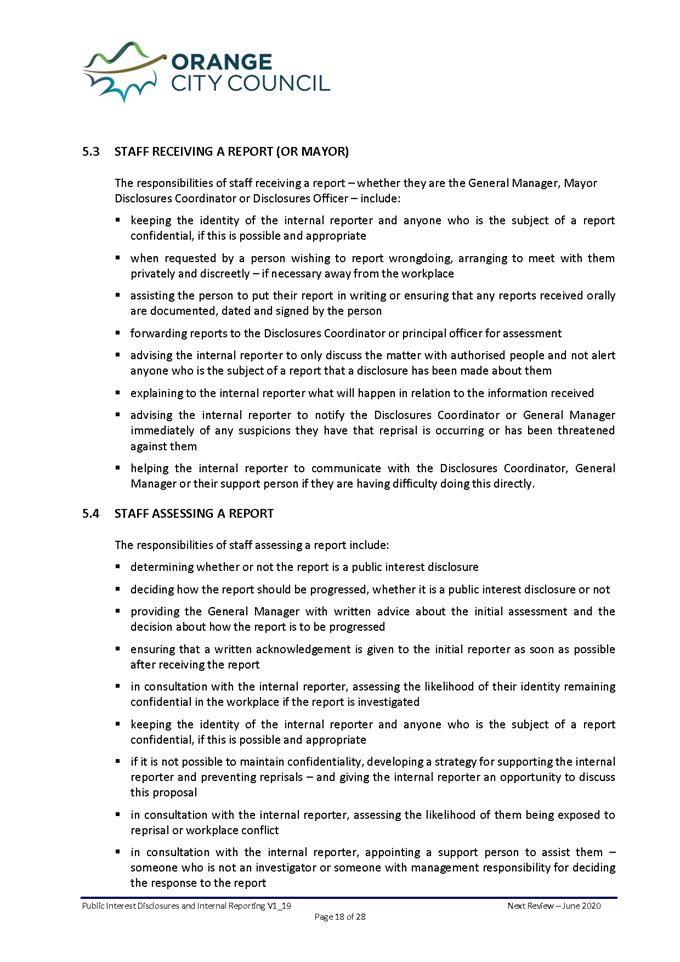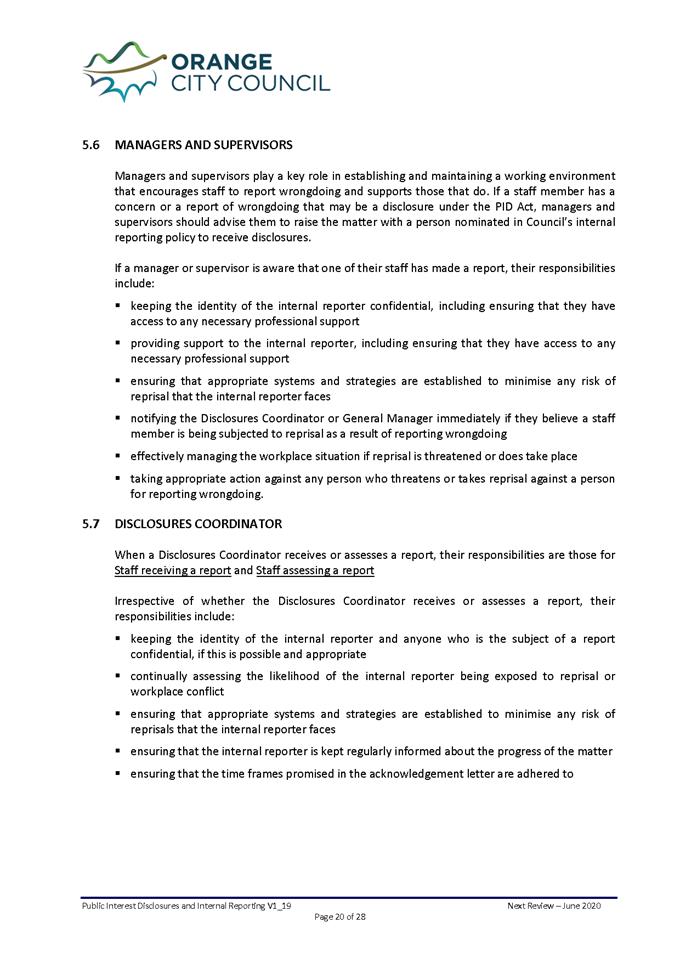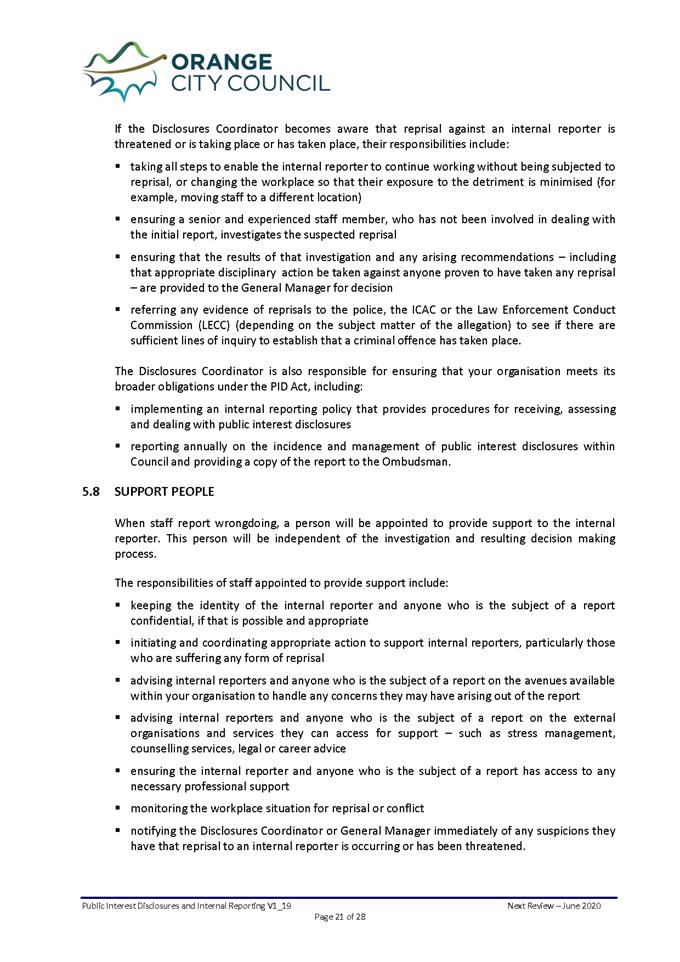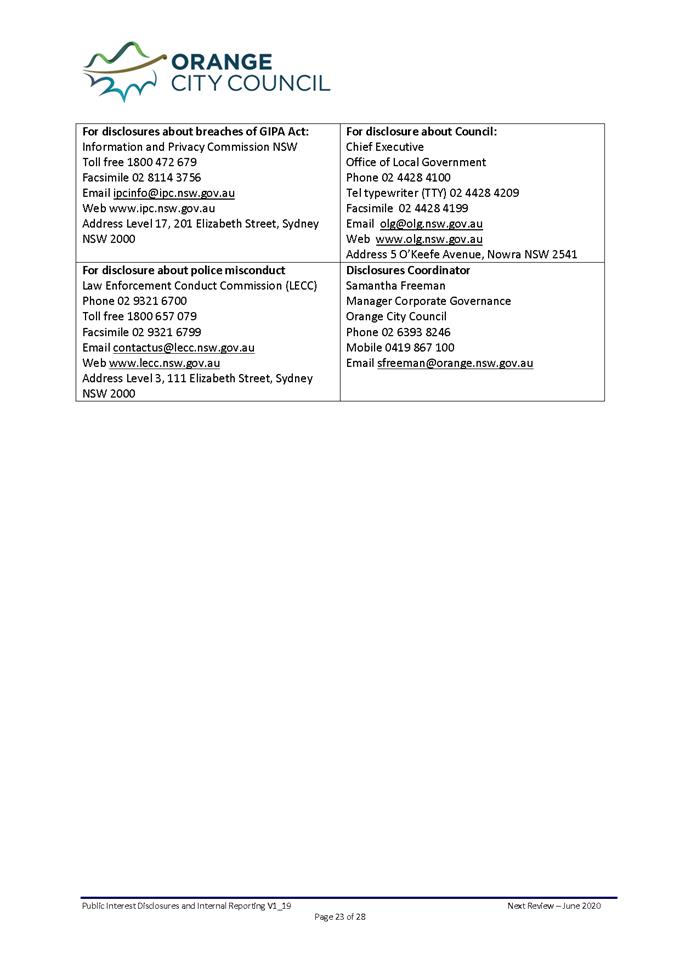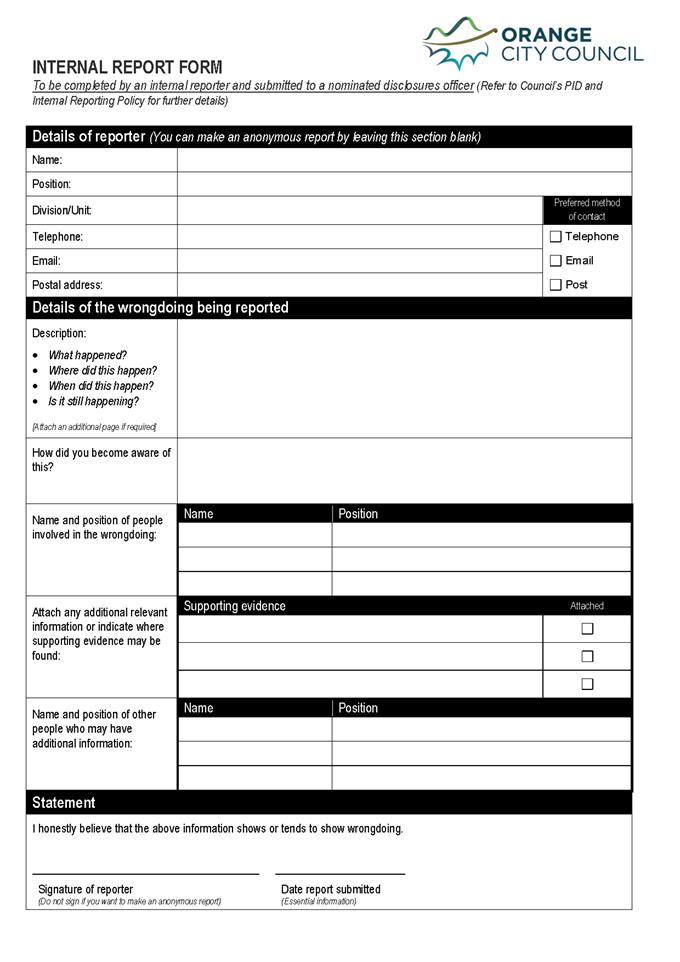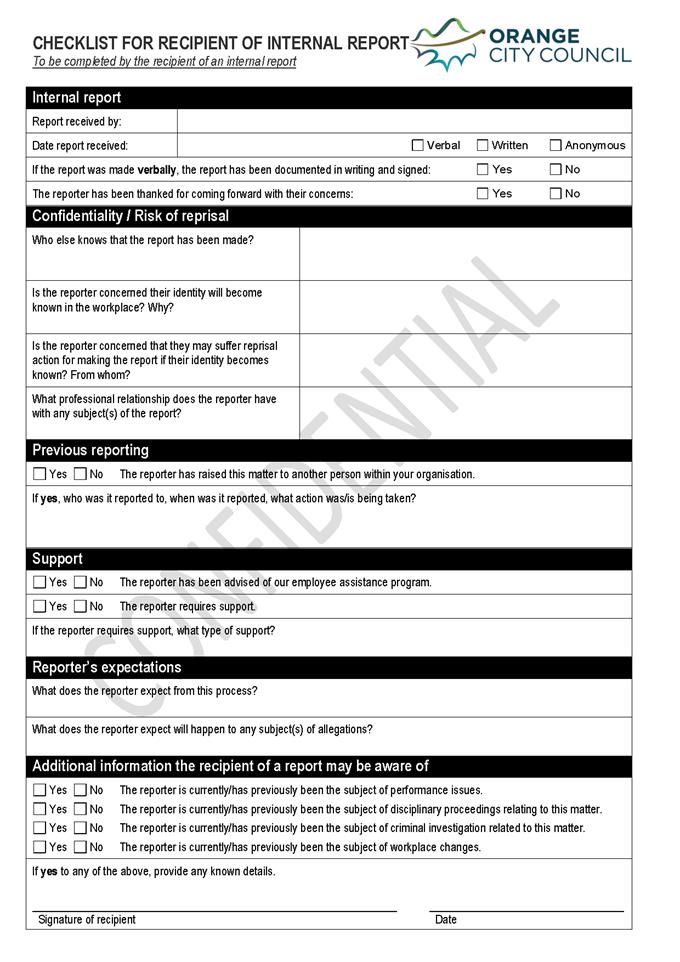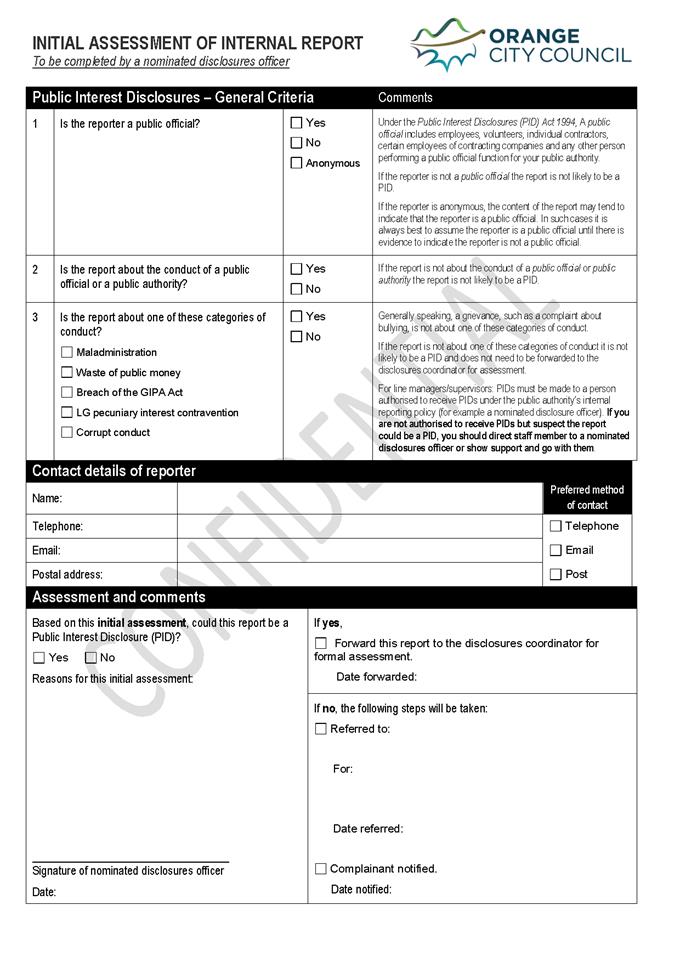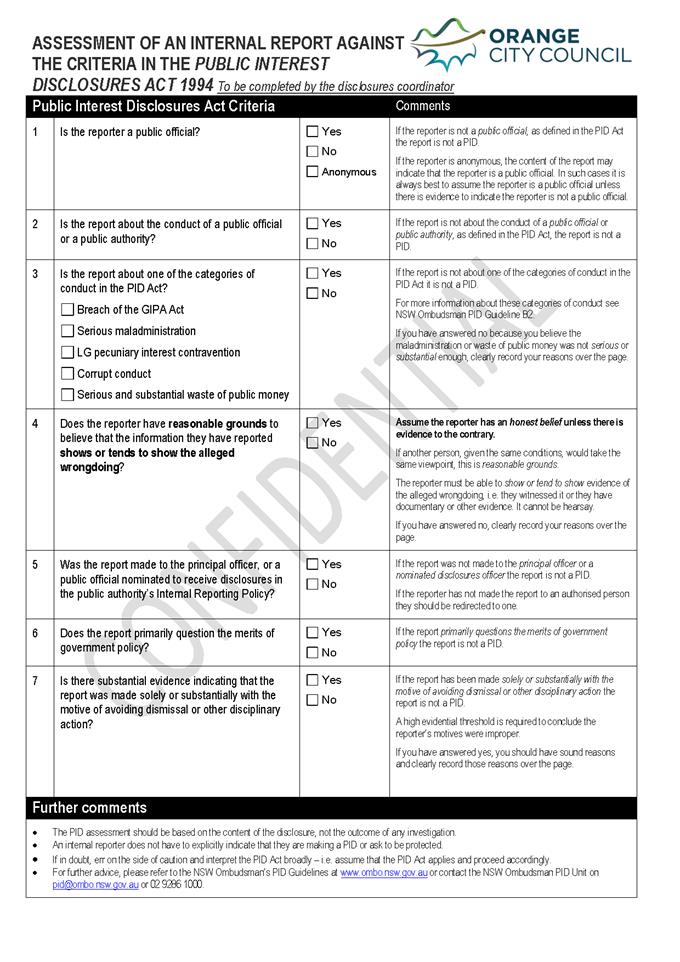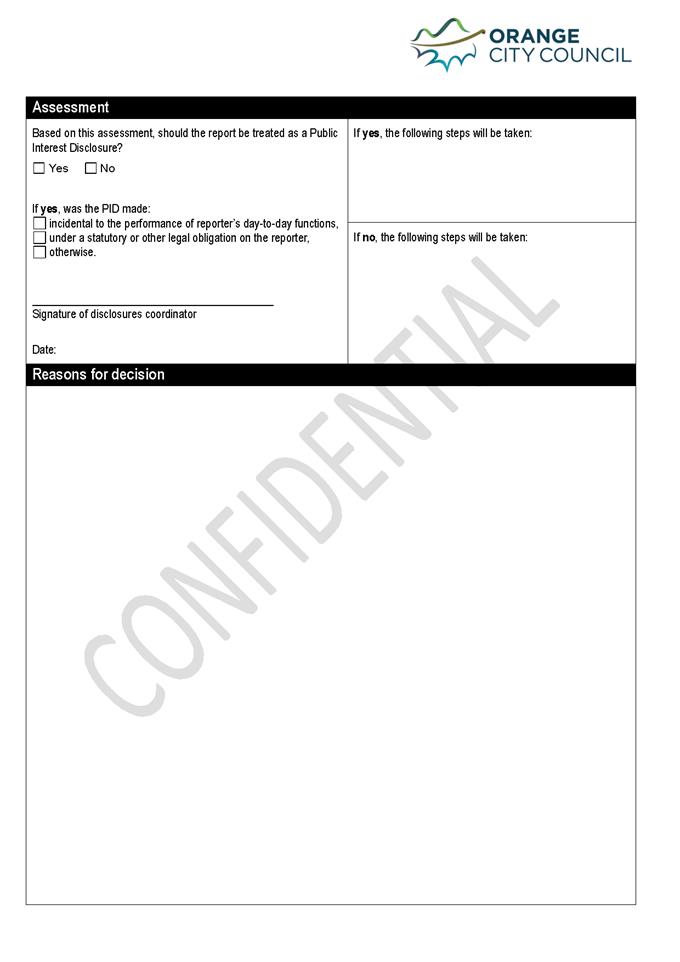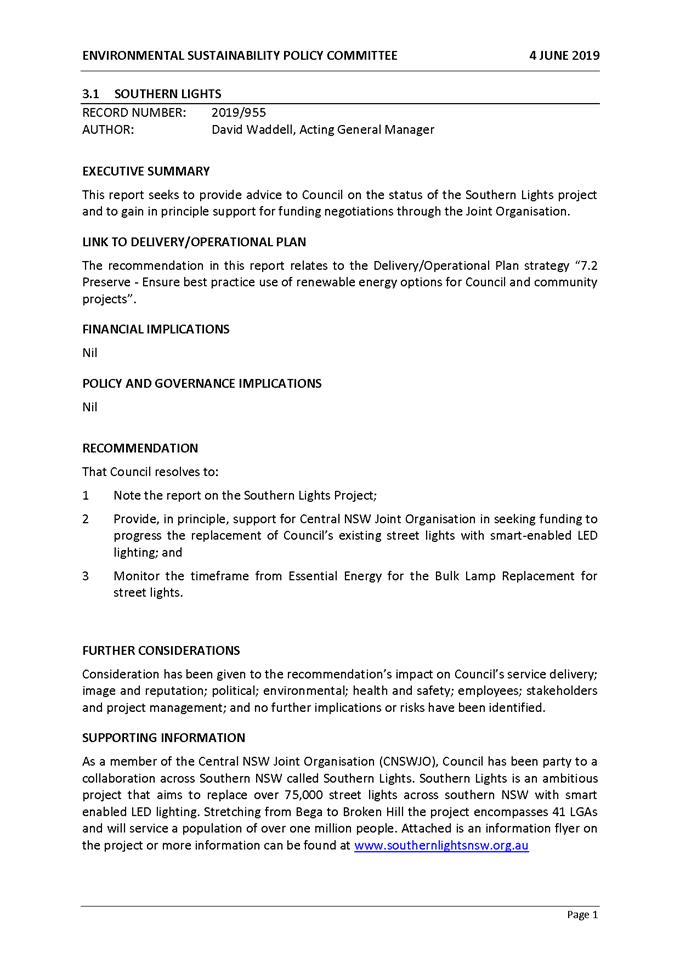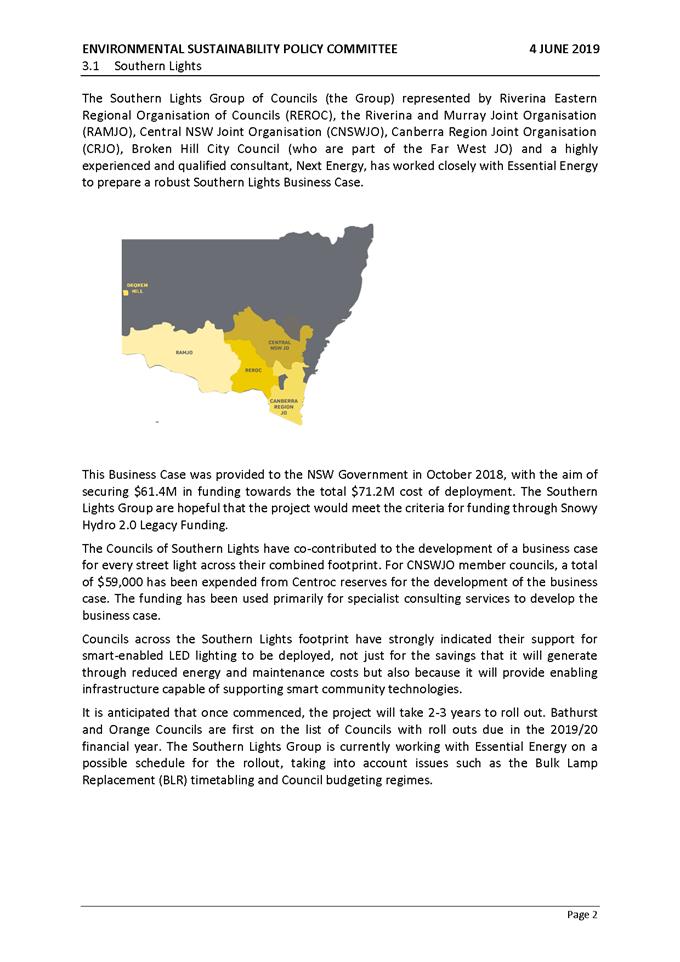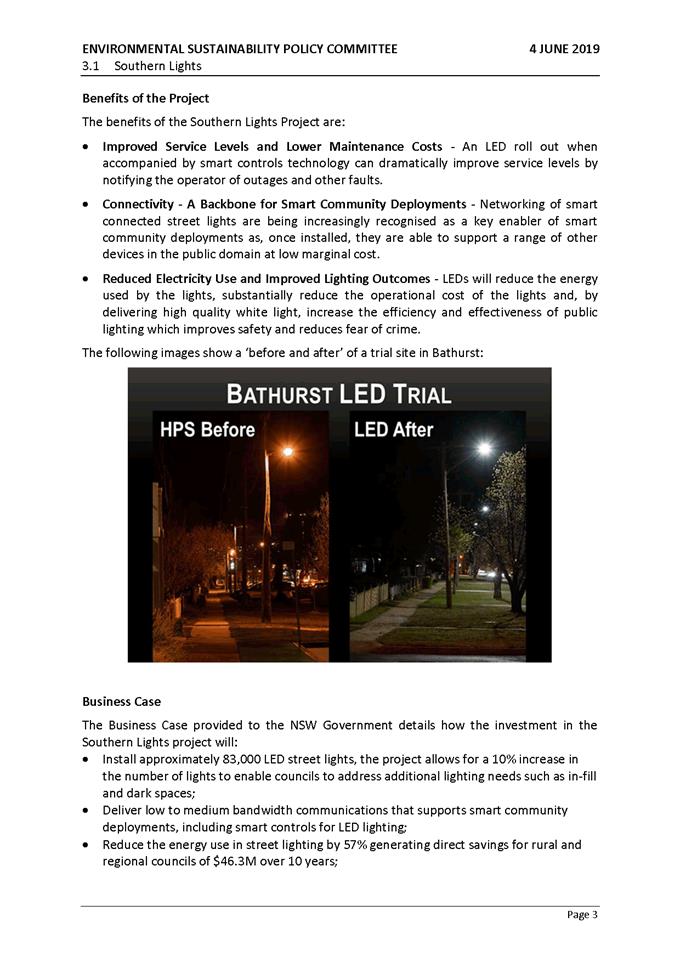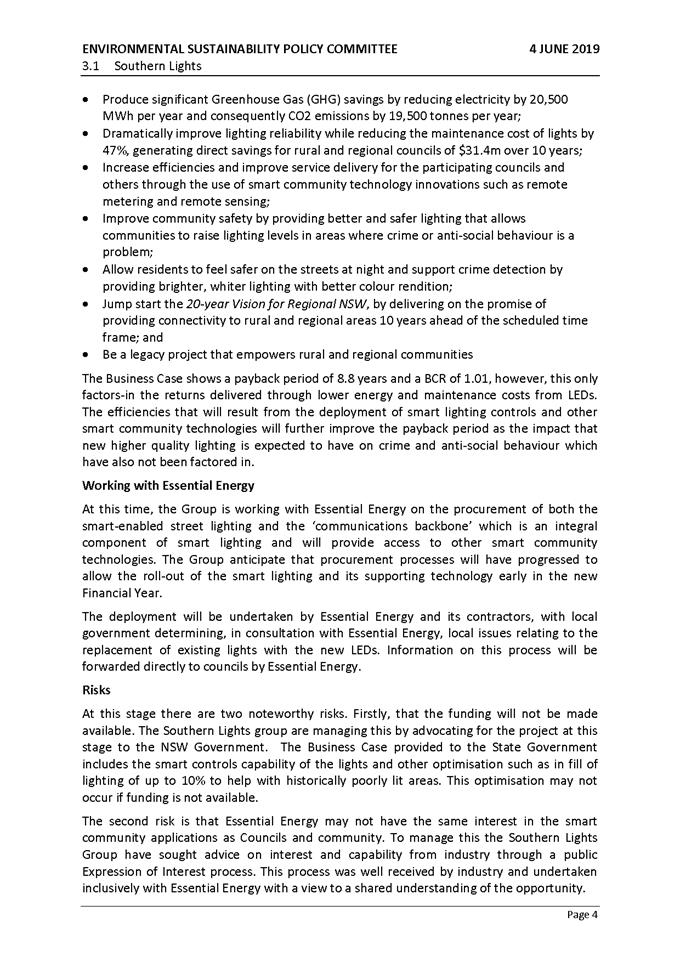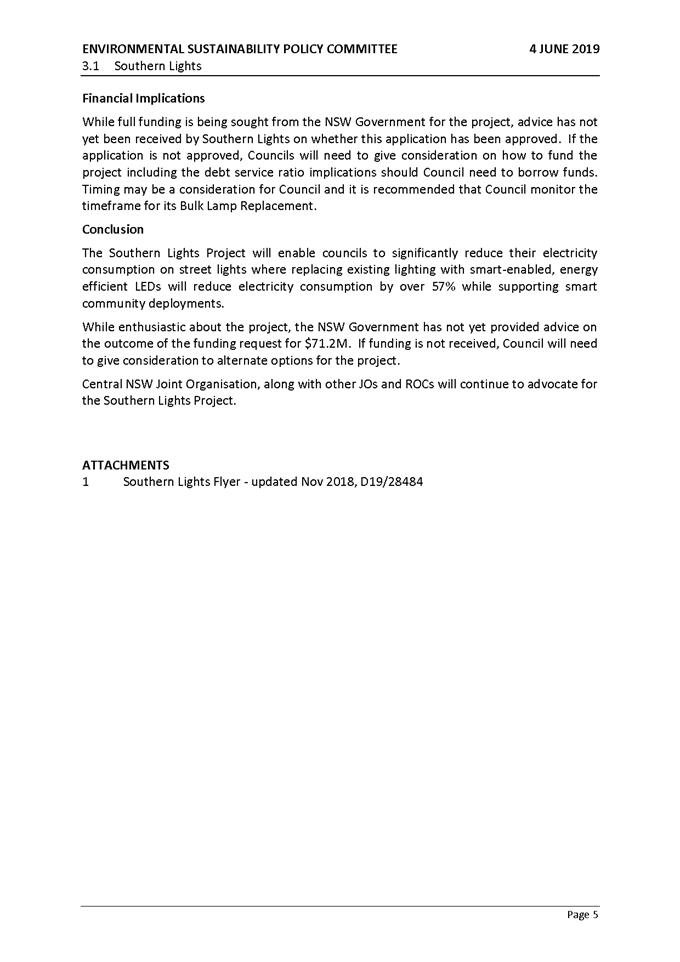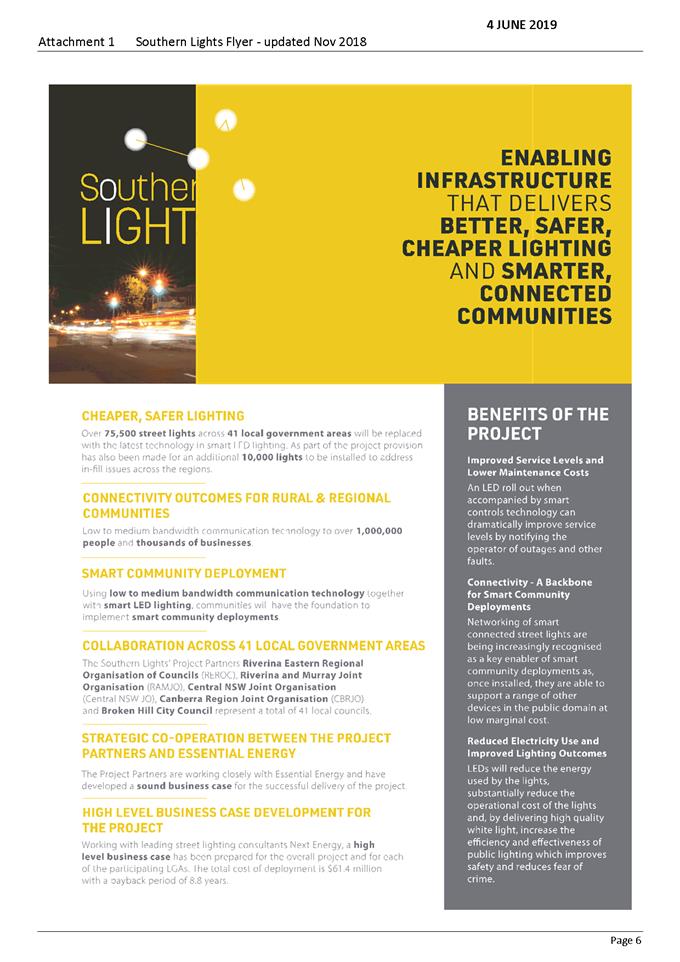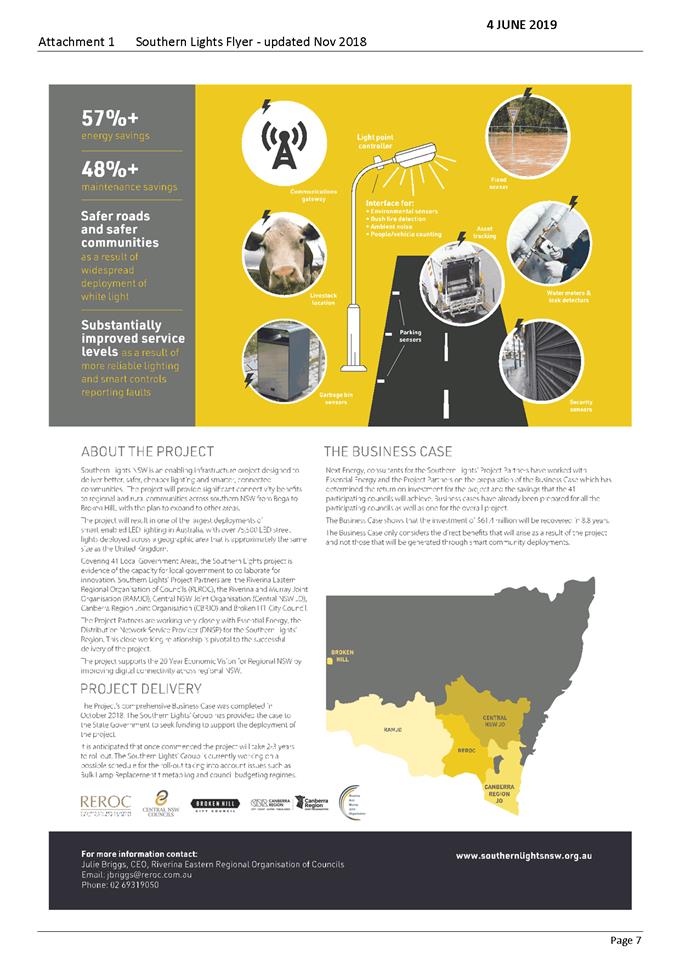5.2 National
General Assembly - Report by Cr Joanne McRae
RECORD
NUMBER: 2019/1475
AUTHOR: Joanne
McRae, Cr
EXECUTIVE Summary
I recently attended the National General Assembly of the
Australian Local Government Association at the National Convention Centre in
Canberra 17-19 June 2019 with fellow Councillors Kidd, Mileto and Duffy. I
provide this report to Council as a summary of speakers and workshops attended.
Link To Delivery/OPerational Plan
The recommendation in this report relates to the
Delivery/Operational Plan strategy “16.1 Collaborate - Work in
partnership with other Councils, regional organisations and State and Federal
Governments”.
Financial Implications
Nil
Policy and Governance Implications
Nil
|
Recommendation
That the report by Cr Joanne McRae on attendance at the
National General Assembly of the Australian Local Government Association on
17-19 June 2019 be noted.
|
further considerations
Consideration has been given to the recommendation’s
impact on Council’s service delivery; image and reputation; political;
environmental; health and safety; employees; stakeholders and project
management; and no further implications or risks have been identified.
SUPPORTING INFORMATION
Monday 17 June 2019
Acting Prime Minister’s Address - The Hon Michael
McCormack MP
Pools and libraries cost a lot of money. LG as first tier of
government is important.
Discussion of swings and roundabouts - parks and roads being
important in Local Government planning —> infrastructure development
across the nation.
Local Government should be recognised in the Constitution;
referendum required; ability to fund directly from Federal Government.
Federal Assistance Grants - reductions, some contribution
from Roads to Recovery funding but ability of Federal Government to fund
directly.
Parkes, Temora, Gwydir and Nth Queensland mentioned in his
talk, flood support and drought funding, along with individual projects funded
by Federal Government in recent times. Some talk of the proposed National Water
Grid.
ALGA President’s Address - David O’Loughlin,
ALGA President
Reviewed 12 point program for support as advocated during
federal election campaign.
Extra 25% in Roads to Recovery. Black spot funding $160M.
Bridges program increased from $25M to $80M.
Limited success in additional road safety funding (eg. truck
stops).
$26M for disaster resilience is a small increase, much less
than the $200M/year requested.
Some funding support for healthier communities and for
Indigenous housing in remote communities, but still short term and limited
impact.
Discussion on circular economy and recycling, but still
limited in real funding. Some focus on energy efficiency as well as product
stewardship for some products.
Climate change: not a lot of action.
Limited access on equitable access for community services.
FAGS continue at 0.55% of Commonwealth revenue, proposed
that there should be acknowledgement of funding in budget to say ‘thank
you’ to Federal Government.
“Celebrate and share what we do well, challenge and
change what we don’t”.
Potential vision for Local Government:
o “The
most efficient and effective level of Government”.
o “The
safest road network in the country”.
o “More
trusted than the Red Cross”.
o “Greatest
Council Ever”.
Reminded of “A fairer share” focus in ALGA
communications and promotions. Acknowledgement of the Federal funds already
provided in developing new funding requests.
Keynote Address – The
Federal Election and Local Government
Karen Middleton, Chief Political Correspondent, the
Saturday Paper
Caution advised in the interpretation of election
information and predictions of election results or polls: mood and inclinations
should be heeded. Market segmentation, targeting to strategic geographic
locations and social media methodologies increasingly important in assessing
political progress. Beware of echo-chamber of social media. Niche policy
resonance (e.g. franking credits) broader than those directly affected by the
policy, including broad community impressions and misinformation; scare
campaigns.
Constitutional recognition of Local Government requires
clear messaging regarding benefits, if the referendum is to be successful.
Continued relationship building suggested for Local Government
or other stakeholders, in light of changes to Federal Government in terms of
electoral cycles and changes. Example used was Keating Government v Hewson GST.
Post Election Opportunities for
Local Government
Panel of Mayors from Parkes NSW, Gawler SA, Diamantina QLD
discuss the implications for Local Government of incoming Federal Government
policy:
Roads, climate change, sport and recreational facilities,
retaining population in regional and rural areas, education access.
Examples of 3-way cooperation to support communities:
targeting of senators from your state who will champion projects in your
communities, building relationships and maintaining focus; examples include
sport & recreation, transport, communication.
Keynote Address – Crowd
Powered Communities
Steve Sammartino, Australian Futurist, Author,
Technologist and Speaker (Steve Sammartino.com)
Exploring a future in which the technology of design and
production are in the hands of our communities, including individualisation of
devices, programming and malleability of products. Crowdfunding as a way to
develop infrastructure for communities, including crowdsourcing as a way to
engage the community to invest in and connect with their own communities.
Challenge legacy thinking in addressing challenges of
commuting traffic, best use of technology, and running experiments to prove
what works. Including, for example, charging for electric vehicles wherever
vehicles stop.
Solar now outperforms fossil fuels in every measure. Glass
solar panels are emerging technology which should replace windows.
Drone landing pads need to be built in local communities as
drone delivery and transportation improves in cost-ratio.
Focus areas:
· Invest
10 minutes every day in understanding emerging technologies
· Side
project which you assist or contribute to, advancing progress
· ‘Humans
first’ as a focus for technologies that serve human needs and put humans
first
Technology is an equaliser as devices are affordable across
human population, rather than being only accessible to the wealthy. This is
unique to our time.
Councils using Technology to Excel
Lifesaving Communications During Natural Disasters
Eileen Deemal-Hall, CEO, Wujal Wujal Aboriginal Shire
Council
Using predictive data to be able to provide community
facilities and readiness for disasters, future focus for impact on the next 5
generations.
Priorities: water security, energy security, food security,
culture
Partnerships and alliance with Army Reserve in developing
micro-grids for energy security.
Australia Day: 13.5m rain in 4 hours, showed scenario
mapping and 3D overlay; technology was critical for communication to manage
safety and survival issues; how to ensure communication is maintained during
critical incidents.
Important to build adaptive capacity of communities when
there is change and change is unavoidable. Climate and country is changing and
so must we. Resource management, food security and innovative solutions to
secure needs for communities. Ensure your planning embraces technological
opportunities to manage building and construction (eg. repair of roofing
damaged by cyclones by 3D printing rather than transportation from main
centres).
“The culture of community is reflected in the culture
of leadership”
“Learn to fail beautifully so you can get back up
again” “Do not fear failure, embrace it, get stronger and do not
stay on the ground too long”.
Bundaberg Region’s Intelligent Community
Ben Artup, Executive Director, Strategic Projects and
Economic Development, Bundaberg Regional Council
Intelligent Community Strategy, digital opportunities for a
future-fit region. Using digital technologies across infrastructure, services,
economic opportunities and problem solving. Open data is valuable to various
stakeholders, and making data and information available, plus systems to
disseminate, create better decision making for the community and businesses.
Case studies: urban glow in Bundaberg; lighting impacts on
turtle population. Recent implementation of a sensor network which can assess
light data and urban glow information with data collection, informing real time
change to manage light pollution. Similarly, this may link to smart street
lighting with sensor activated LED lighting or other opportunities. Funded over
Smart Cities and Suburbs Program ($1.3-2M project).
Case study: Intelligent energy management in developing a
data analytics platform to identify energy consumption and utilisation across
council sites.
Case study: Intelligent water meter pilot, using new
technology across residential and commercial properties for water consumption,
applicable to other utilities in the community.
Case study: Challenger Learning Centre with STEM mission
focus based around NASA, engaging school communities around the world for
citizen scientists.
Let’s Talk About 21st Century Government
Colin Fairweather, CIO, City of Melbourne
Daniela Mazzone, Principal Lead, IT Capability and
Partnerships, City of Melbourne
Discussion of challenges to traditional thinking, 19C
thinking on 21C technology. Prepare for a future that it digitally centric and
increasingly technology centric. Delivering a technology platform for the 21st
century is a challenge in local government.
1 Know
your customer interfaces and communications (how customers want to engage) eg.
Self-service digital, easy and quick, deliver on promises, support with a human
when it is needed;
2 Digital
human centred design;
3 Data
is under control but also accessible.
Unlocking the Treasure of Australia’s First
Languages
Melinda Holden, Director, First Languages Australia
Karina Lester, Director, First Languages Australia
Geoff Anderson, Director, First Languages Australia
www.firstlanguages.org.au
2019 is the International Year of Indigenous Languages.
Consider the opportunity to look at what Parkes has been
doing for Wiradjuri language, and embedding and supporting language and culture
in the wider community. Parkes Wiradjuri language group; Parkes Elders group
meet quarterly, with meetings held in the Council Chamber.
Consider opportunities to name festivals or events using
local language, and incorporate opportunities for celebration of local
Indigenous language.
Day 2:
Housing, Infrastructure and Population
Australia’s Future Infrastructure Challenges: The
2019 Australian Infrastructure Audit and What it Means for Local Government —
Romilly Madew AO, Chief Executive, Infrastructure Australia
Independent with 2 Ministers: Deputy Prime Minister, Michael
McCormack (regional), Alan Tudge (urban, cities population & housing).
Local Councils have an important role to play in housing
planning in communities, considering liveability and connection with existing
resources.
Access, quality & cost are the priorities for
Australians in infrastructure. More than 70% of GDP growth has occurred in
Sydney, Melbourne, Perth & Brisbane.
Australia is growing faster than global averages.
Transport infrastructure needs to keep up with growth in
cities, including infill development focus and growth in the urban fringe.
Audit will address transport, telecommunication, energy,
water and social infrastructure (paths, waterways, arts and culture). It will
address issues in funding and financing services as well as maintenance of services
(which often falls to local government). Focus on places - categorises various
sized communities in addressing opportunities.
The Role of Local Government in Housing Australians in
the 21st Century - Professor Andrew Beer, Dean of Research and Innovation,
UniSA Business School
Local Government as stewards of the community; UTS and UniSA
research project with local councils across NSW, VIC and SA.
Local Governments are taking a new role, leading in
initiatives to address housing crisis in Australia; social housing not able to
meet demand.
In some cases statutory requirements from State or Federal
are pushing local government to take on this role.
Pressures on Local Government including: AirBnB as
opportunity or threat; population decline in rural areas; unaffordable housing;
pressures on infrastructure funding. Cost shifting impacts on Local Councils
(eg. rate exemptions for housing associations) or other forms of revenue
forgone to support affordable housing; tensions between being the
regulators/approval authority and opportunities to be more active and proactive
in the housing space.
Councils respond in different ways to these challenges,
depending on the leadership Councillors offer their communities.
Consider the opportunity to promote the assistance Local
Government provides to housing: supporting community organisations, ensuring
supply of land, engaging with other tiers of government, development and
implementation of planning schedules, and co-ordination of social services.
Also opportunities to share good practice in housing as different local
government areas take a role in housing. Perhaps this is mediated by fear of
further cost-shifting by other tiers of government.
Opportunities to address homelessness through active Council
engagement, population growth and housing market, or affordable land provision.
Why and How Local Government and the Private Sector
Should Work Together to Increase Affordable Housing
Robert Pradolin, Founding Board Member, Housing All
Australians
Housing and homelessness issues - private sector taking
leadership in addressing the increasing issues in housing access for all.
“An Australia where everyone has a stable place to call home; no matter
if they are rich or poor”.
Local Government are left to solve a problem that other
tiers ignore as there are no votes in it. “To harness the ability of the
private sector and collaborate to address the chronic shortage of low income
housing.”
This includes using existing housing stock to provide pop-up
or short term housing for groups at risk, as well as longer term solutions.
Public housing v affordable housing; addressing the
perceptions of value and shift in management attitudes from the private sector.
Shifting attitudes of users to understand profit and purpose in private sector
developers taking on social and affordable housing.
Argued that opportunity to develop trust and deliver
results, without interference of state or federal government.
Gary Spivak, Housing Development Officer, City of Port
Phillip
Private rental affordable housing delivery model. Inner
Melbourne Action Plan addresses housing issues, exploring different options
under the PRADS model: rent to buy, shared equity housing, community land
trusts, NRAs, and affordable build to rent.
Where people move up and down the housing models, there is
increasing demand for housing flexibility to meet their needs; low income wage
earners need to be accommodated in close proximity to employment. This is a
focus on eliminating the bottle neck in housing, where those moving from
privately owned or rented housing, through more affordable housing, to social
housing.
Opportunity to include mandatory planning mechanisms, for
example: Amendment C70 City of Melbourne; Model s173 Agreements for affordable
housing.
PWC investigating IMAP project on a pro-bono basis,
considering the modelling, types of housing products and opportunities most
applicable to the model, defining the minimum necessary development margin for
development viability, and the incentives necessary to bridge the gap between
market & discounted rent.
Project is expected to conclude in September with report and
modelling available in public domain, available to interested parties.
Disasters – Are You Ready?
Naomi Westwood, Acting Assistant Commissioner, Business
Registry, Australian Taxation Office
Free service available for assistance in managing disasters
24/7, also useful in procurement and service delivery, planning and economic
development and compliance.
Disaster Management: Mitigation and prevention, preparedness,
response, recovery cycle
What can be used, where and what businesses are at greater
risk.
Eg. Hazardous and flammable materials held within community
(ie. sites in industrial areas).
Use the ABS data to contact directly, either for assistance
or information. Case study of floods in Townsville QLD, providing an event
footprint as a map, or other forms of information provision as needed to assist
with management of the event.
Other opportunities could be for monthly newsletters,
industry sector forums, retail shopping engagement or new businesses and
engagement opportunities.
Concurrent Sessions:
Reducing Community Harm – attended by Cr
Mileto
Alcohol and other drug harms are prevalent in our
communities. To provide insights into the benefits of preventative initiatives,
international expert and council experiences will be explored.
Working With Local Government in Alcohol and Drug Misuse in
Youth – A Preventative Approach from Iceland — Dr Jón
Sigfússon, Director, Planet Youth, Icelandic Center for Social Research
and Analysis, Reykjavik University
An Australian Community Led Approach to Alcohol and Drug
Misuse — Dr Erin Lalor, CEO, Alcohol and Drug Foundation
Blue Mountains Local Drug Alcohol Team — Lead
organisation: Blue Mountains City Council, Representative: Cr Don McGregor
Murray Bridge Safe Drug Action Team — Lead
organisation: Rural City of Murray Bridge, Representative: Cr Brenton Lewis
Moree Local Drug Action Team —
Lead organisation: Moree Plains Shire Council,
Representative: Mark Connolly, Economic and Community Development Manager
Your Community, Your Environment –
attended by Cr Kidd
Recycling and Climate Change are the two biggest
environmental issues facing Local Government.
How the Australasian Recycling Label will Assist Local
Government in Reducing Recycling Contamination Rates — Peter Brisbane,
Government Partnership Manager, APCO
Ryan Collins, Head of Sustainable Resource Programs,
Planet Ark
Developing Australia’s Circular Economy — Rose
Read, CEO, National Waste Recycling Industry Council
Promoting Regional Circular Economy through use of Glass
Sand and Recycled Organic Compost in Council Projects — Tony Farrell,
Deputy CEO, Lake Macquarie City Council
Climate Change Action in Alice Springs — Damien
Ryan, Mayor, Alice Springs Town Council
Housing your Community – attended by Cr
McRae
Australia is confronted by escalating housing challenges.
This has fuelled a search for new policy solutions and a new range of actors,
including local governments.
Australia’s Local Governments: Comparing Sydney and
Melbourne with Other Metro, Regional and Rural Centres — Professor
Alan Morris, University of Technology Sydney
ARC linkage - research on gentrification of metropolitan
areas and impact on housing affordability. Investigation of data from 178 Local
Councils, presenting data on responses to perceived affordability, workers and
housing cost, housing policy around affordability, Council priorities and
attention to housing affordability and barriers impacting on council focusing
on the topic. Also inquired into overcrowding and homelessness.
The Impact of Airbnb on Housing Markets — Laura
Hodgson, PhD Scholar, UniSA
3rd Year PhD Student looking at NSW housing markets in case
studies; form of disruption to traditional commercial markets with various
stakeholders.
Questions the impact on housing, where housing stock
previously rented is now AirBNB and reduces available housing stock. ‘New
state spaces’ as the underlying theoretical framework, where 3 levels of
government are involved and may have competing interests. AirBNB is considered
a global actor in local markets.
In general, viewed across Australian states as an asset for
economic growth.
Case studies: Northern Rivers, Lismore, Ballina, Byron;
Sydney: City of Randwick, City of Sydney; “inside AirBNB” provision
of data = 27,360 listings in Sydney
Interviews were conducted with Local Council staff and
Councillors, real estate agents in each location. Questions regarding
monitoring and enforcement of 180-day limits, as well as adherence to code of
conduct for visitor management.
How Councils Can Assist With Affordable Housing
— Lenka Thompson, PhD Scholar, UTS
ARC Linkage Project LP150100160
Housing as a commodity: increasing housing costs and housing
stress, increasing homelessness, longer public and social housing waiting
lists, increasing insecurity, and risk of homelessness applicable to anyone.
It may not be an issue that council hears about directly
from those affected - concerns raised by others in the community.
Case study:
A) surplus
Council land sold to housing provider for specific designated target group (at
risk women and children), where greater weight allocated to applications
related to social housing.
B) gift
Council land to housing provider for at risk youth, 6 bed home for young mums
& babies with a carer 24/7 (funded by housing provider, charity and
provider developer + Council’s gift of land).
C) Land
swap for 26 units for people at risk of homelessness; council negotiated with
private landlord for a property exchange to provide 3 blocks adjacent (Federal
Government, housing provider as leaders, but Council facilitated the swap).
D) Ageing
community hall had 59 new dwellings developed for low-moderate incomes; item
transferred to the housing provider on condition of renovation of the hall
while units being developed, ended with council leasing back for 99-year lease
(philanthropic fund, housing provider + Council as lessee).
E) A
company (limited by guarantee) developed land assets with housing providers or
philanthropic entities to deliver projects in specific area. Council’s
role was to set up and register the company, develop constitution in line with
council aims and assist with first board being developed and staffed;
F) Car
parks: airspace above Council carpark was provided to develop housing stock for
affordable housing. Maintained car parking with additional housing available by
providing the housing provider with the airspace rights (27 studio apartments).
One challenge in local government is whether the ideas are
lost as varied opinions, changeover of Local Councillors and staffing
segregation.
Affordable Housing in Waverley LGA: Challenges and Ideas —
Tim Sneesby, Manager Strategic Planning, Waverley Council
Local housing strategy in a high density metropolitan
council, where there are many young urban professionals and high percentage of
renters. Need to ensure that the key industry workers (retail, health,
education) can afford to live near their work. Being able to live nearby
reduces geographic isolation and marginalisation.
Consideration of the percentage of AirBNB penetration in the
local market, as Waverley also has the highest in Australia; with redevelopment
leading to the loss of affordable rental stock (eg. 58 dwellings lost in
2017/18). Low cost affordable housing is being lost as inter-war flats are
demolished to build large, luxury developments.
Commented “increasing the housing supply would not
‘trickle down’ to create more affordable housing”.
3 streams to the council affordable housing:
a) Affordable housing: 25
units paying 70% of market rent, with 3 year term.
b) Over 55s: 47 units, 25% of
income + rent assistance
c) Housing for people with
disability: 3 units, limited terms as transitional housing
Housing stock was captured in the planning controls
initially, but has now transitioned to Voluntary Planning Agreements (5% in
effect).
Funding ideas presented, including VPA, Affordable Rental
Housing SEPP, Inclusionary Zoning (SEPP 70), and contributions review (2-3% for
all, higher % for uplift impacted, or contribution offsetting the loss of
affordable housing).
Innovative approach to subsidising rents by using VPA
contributions to purchase commercial floor space, renting this at market rates
and subsidise rental dwellings to subsidise units.
Questions which arose:
May need to consider language used for social or affordable,
as perceptions of community may impact on acceptance and approval from
neighbours; consider key worker housing, liveable housing.
Issues with monitoring of actual ‘days online’
advertising and impacts on how much housing is available in a community.
Should Council consider being the land developer: can
Council do it well and at lower cost than private developers?
The Hon Jason Clare MP, Shadow Minister for Regional
Services, Territories and Local Government
Spoke to the challenges of the current economic climate,
employment and economic growth. He spoke of the Labour Opposition viewing local
government as partners rather than stakeholders.
Reinforced that every MP receives $150,000 for funding in
their electorate.
Day 3:
Engaging with your Community into the Future
Kylie Cochrane, Community Engagement Specialist, Aurecon
Priorities will vary amongst community members, social
change, change in community trust ‘death of community trust’, what
community activism look like and key community engagement trends that Local
Councils face at present.
Democracy definition and 4 key principles. Democracy is
being impacted by WIIFM, NIMBY, and skewed definition of consultation (eg.
Petitions, vote); social triangle theory: self, religion, community (friends,
family, neighbours)
In the last decade, $20Billion of road projects have been
cancelled, delayed or mothballed due to community opposition.
Key trends faced in community engagement:
1 Meaning is a critical social
motivator (feeling belonging and purpose)
2 Community = people and place
3 Social media is a game changer
(seek, source and share information)
4 All projects are political
5 Protestors anyone and everyone
“Yes in my backyard”: YIMBYs I want the
services, easy access, and will support projects - within reason, and want to
be involved. They are supportive, as long as they can see community benefit.
Co-Design and shared power are critical to maintaining effective community
engagement.
Dealing with Disaster – New Zealand Perspective
Samantha Kennedy, Head of Australia, New Zealand and Asia
Pacific, Pivotel
Satellite technologies enabling communities in critical and
remote environments: remote and isolated workers, environmental management and
bio security, remote sites and communities, disaster and event response.
Andrew Howe, Emergency Management Advisor, Civil Defence
and Emergency Management, Canterbury
Civil Defence Emergency Management:
· Reduction,
readiness, response and recovery (4Rs).
· Managing
all hazards (natural and non-natural).
· Functional
based planning
· Coordination,
or integration of agencies
· Everyone
playing their part
Provided an overview of emergency management in Christchurch
applied to earthquake, flooding, disease and terrorism.
Six Layers of Intentional Leadership
David Pich, Chief Executive, Institute of Managers and
Leaders
Discussion of leadership, will present at individual
Councils as required.
Accidental manager v intentional leader
6 Layers of intentional leadership, focus on 3:
1 Self-awareness
is crucial (trumps authenticity hands down) with recommendation to complete 360
degree reviews on an annual basis
2 Decision making:
make time to think before you act and plan before you act, safe and healthy
workplace
3 Reflection,
adjusting and acting are integral to change; assessing what you will do
differently in the future.
‘Thank you’ is important, and leaders need to be
aware of gratitude to team.
Minister for Regional Services, Decentralisation and
Local Government
The Hon Mark Coulton MP
Discussion on breadth of Local Government, specific examples
from rural Councils. Proposed that there will be improved communication through
local government networks set up by Federal Government.
Advocated for projects that address local concerns as a
priority, particularly connecting young people and employment opportunities.
Example of Sterling WA Kaleidoscope project, winner for National LG award 2019.
Smart Cities: $50M competitive program for technology based
projects addressing liveability issues across Australia. Industry, research,
technology and manufacturers partnering with Local Government to build
capability.
Answered questions regarding Federal Assistance Grants,
delays in citizenship applications, recycling/waste levy.
Keynote Address – Overcoming the Odds Kurt
Fearnley, Paralympic Champion
Discussion of strength and belief in achieving set goals,
reflections on achievements and experiences, access for people with
disabilities. Challenging public policy to deliver to the community, addressing
employment issues for people with disabilities, and challenging stereotypes and
expectations. Education, employment and sport as critical ways to give people
with disabilities opportunities, and setting new expectations for individuals.
His experience growing up in Carcoar - of being told he was
strong, and valued. That reinforcement on a regular basis, and in actions shown
by others, set an expectation for him for life. Ensure we pass on the message
to be strong and valued for all people in our community, including people with
disabilities.
Encouraged Local Councils to listen, build and invest in
disabled voices in your home town.
5.6 Southern
Lights Project Update
RECORD
NUMBER: 2019/1554
AUTHOR: David
Waddell, Acting General Manager
EXECUTIVE Summary
This report provides an update on the progress of the
Southern Lights Project and seeks Council’s endorsement to proceed with
the conversion of Orange’s street lighting network to Light Emitting
Diode (LED) fixtures.
Staff are recommending in this report that OCC accepts
Essential Energy’s offer for the replacement of all Orange City street
lighting fixtures with the equivalent LED technology. The benefits of this
option include the immediate realisation of environmental and financial
outcomes, reduction in ongoing operating costs for street lighting by
approximately $500K, minimising initial investment through aligning the
conversion to LED fixtures with the scheduled Bulk Lamp Replacement and
enhancing community safety.
Link To Delivery/OPerational Plan
The recommendation in this report relates to the
Delivery/Operational Plan strategies “3.2 Live - Partner
with key stakeholders to deliver infrastructure and activities that improve the
safety and security of the community” and 7.2
Preserve - Ensure best practice use of renewable energy options for Council and
community”.
Financial Implications
It is anticipated that Council will fund the full cost of
the LED bulk replacement through a $2,500,000 loan facility. Essential Energy
has the ability to fund the capital cost up front on Council’s behalf but
given their required rate of return compared to the current low interest rate
environment, it is proposed that Council fund the full cost of replacement over
a five year period. The cost of the replacement will be substantially offset by
savings in energy and maintenance expenditure. It is estimated that the
annual savings resulting from the conversion will be in the order of $500,000.
Policy and Governance Implications
Nil
|
Recommendation
That
Council resolves to:
1 Note the
report by the Acting General Manager;
2 Request
Essential Energy to convert all Orange Street lights to LED fixtures as part
of the upcoming Bulk Lamp Replacement program;
3 Grant
permission to the General Manager or nominee to do such things as may be
necessary or convenient to give effect to this decision, including affixing
the Council Seal to all relevant documents if required; and
4 Adjust
future operating budgets to reflect initial project outlay and ongoing
savings through the quarterly budget review process.
|
further considerations
Consideration has been given to the
recommendation’s impact on Council’s service delivery; image and
reputation; political; environmental; health and safety; employees;
stakeholders and project management; and no further implications or risks have
been identified.
SUPPORTING
INFORMATION
The Southern Lights Project commenced
in 2016 with a number of interested Councils and ROCs collaborating to drive
the conversion of street lighting to LED lighting in order to save Councils up
to 50% of the costs associated with the provision of street lighting and to be
more environmentally responsible. This project proposes to deliver LED street
lights, coupled with digital enabling infrastructure through 83,000 street
lights across southern NSW. The consortium of Councils is represented by
Riverina Eastern Regional Organisation of Councils (REROC), Riverina and Murray
Joint Organisation (RAMJO), Central NSW Joint Organisation (Central NSW JO),
Canberra Region Joint Organisation (OCBRJO) and Broken Hill City Council. A working
party was established with the RAMJO representative being Deputy CEO
Infrastructure Planning an Environment at Orange City Council.
From the initial focus on LEDs, the project has grown to
encompass smart street lighting with the street lighting network being the
vehicle for smart controllers that will lead and support digital technology
advancement throughout regional and rural NSW. This project is one of the
largest proposed deployment, by geographical area, of smart enabled LED street
lighting and encompasses 41 Local Government Areas across a significant portion
of the State as indicated below.
Through the respective ROCs/JOs,
the Working Party engaged a specialist energy consultant, NextEnergy, to assist
with the development of this project. Essential Energy was recognised as a
major stakeholder in the project being the owner and provider of the majority
of street lighting across the area. The Working Party has liaised closely with
NextEnergy and Essential Energy to:
· Develop a business
case, both globally and for individual Councils;
· Develop
specifications and procurement of LED street lighting;
· Develop
specifications and procurement of associated smart technology;
· Develop a
communications backbone that will support the deployment of other smart
communities’ technology; and
· Lobby State
Government for funding for an immediate rollout of smart street lighting.
The most advantageous timing for the
roll out of LED street lighting is to coincide with the respective
Council’s Bulk Lamp Replacement schedule. Under the current service
agreement, Essential Energy is required to replace existing lamps (non LED)
every four years. Initially, Essential Energy had scheduled Orange’s Bulk
Lamp Replacement for October 2018. In mid-2018, Orange requested a deferral of
the lamp replacements until April 2019 to take advantage of the Southern Lights
Project which was subsequently granted. Since April 2019, Council has been
awaiting a specific proposal from Essential Energy to convert our street
lighting stock to LED as part of the scheduled Bulk Lamp Replacement. The
proposal was recently received.
The implementation of the Southern Lights Project will
deliver significant advantages to regional and rural NSW through the following
mechanisms:
· A reduction in street
lighting energy consumption of up to 57%, based on the conversion to LED
technology;
· The improved
lighting reliability of the LEDs will reduce maintenance demands via more
efficient fittings;
· Safer communities
with brighter streetscapes and potentially less crime as LED lighting delivers
high quality white light, with much improved colour rendition than is found in
the current lighting;
· Improved customer
service when accompanied by smart controls with real time failure detection;
and
· Environmental
benefits with the removal of mercury and lead contained products.
Furthermore, the provision of smart
lighting creates a building block and introduces NSW rural and regional
communities to smart technology. Communities can value add and smart street lighting
networks are increasingly recognised as the likely backbone of smart community
developments and once installed can support a range of other devices in the
public domain at low marginal cost. For example, commonplace smart city
technology can enhance services such as parking, traffic management, pedestrian
movements, water usage/measurement, waste management and noise/pollution
monitoring.
Primarily there are three components to the project:
· Light fixtures –
an LED lighting specification has been finalised. The preferred fixture is dual
port; being one port for the smart lighting system and the other port for
individual Councils to value add with smart city devices. Essential Energy has
presented this tender to market (November/December 2018) and a suite of
suitable lights will be available by late 2019 within Essential Energy’s
product offer list;
· Smart Lighting
System – this is the desirable smart meter that controls the lights. An
Expression of Interest process was undertaken by Essential Energy in the latter
half of 2018 to determine product availability which received extremely strong
market responses. A formal tendering process will be completed mid-late 2019,
with smart lighting meters available in 2020; and
· IT Platform
– this is the communication backbone for operating the smart technology
and is typically provided through an open low to medium bandwidth communication
network. This component is currently being developed, ensuring device
compatibility and aligning with the above lighting and smart meter procurement
processes. This is a reasonably straightforward activity and will be available
and align with the estimated project roll out, if funding is achieved.
At a local level Orange City has
been a leader in this space, actively progressing and promoting this project
through various networks. As part of considerations for the recent 2019/20
budget, Council resolved to apply a contingency approach to the project to
replace all street lights within our Local Government Area with LED as part of
the next scheduled Bulk Lamp Replacement.
As indicated above,
Orange’s Bulk Lamp Replacement for October 2018 was deferred to take
advantage of the Southern Lights Project. Recently Essential Energy has
reviewed their asset health and rescheduled Orange’s changeover at the
earliest possible convenience based on increased lamp failures, non-compliance
with standard lighting levels and a deterioration in customer service and
response times.
Orange’s street lighting network consists of
approximately 4,987 lights. Lighting of residential streets (Category P)
includes 4,185 lights and the remaining 752 fixtures service our arterial road
network (Category V). Since the introduction of LED fixtures into the Essential
Energy product list, all new subdivisions have been specified with this
preferred LED fitting.
Timing of the roll-out of the Southern Lights Project
(during 2020) is an immediate consideration for Orange City. Undertaking an LED
conversion that coincides with Orange’s Bulk Lamp Replacement will reduce
the overall conversion cost by approximately $378K. Essential Energy has
advised that due to poor asset health, increased lighting failures and
potential non-compliance with regulated performance, the Orange Bulk Lamp
Replacement cannot be deferred any further. Accordingly, Essential Energy has
provided an indicative LED conversion proposal based on commencing the Bulk
Lamp Replacement from October 2019.
From a financial perspective, Essential Energy has provided
a summary estimate of costs associated with the conversion of all (Category P
and Category V) Orange’s street lighting assets to LED technology. The
upfront capital contribution for Council will be in the order of $2.5M, which
is in line with previous estimates and extrapolating budgets across both
Category P and Category V lighting. Council will be eligible to claim one off
Energy Savings Certificates through the NSW Energy Saving Scheme with an
estimated value of $274K.
Therefore, the net capital contribution for Council is in
the order of $2.5M. Based on the existing fixtures and proposed replacements,
the estimated annual savings through energy consumption and maintenance is
$500K. Therefore, the project payback is approximately 5 years and provides
great value. It should also be noted that the available technology is
smart-ready LED lighting fitted with a standard photoelectric (PE) cell and
without the optional port (not currently available). As smart control devices
become available in the future, conversion of the PE cells to smart controllers
is a relatively straightforward process.
Attachments
1 Southern
Lights - Copy of report from ESPC 4 June 2019, D19/43603⇩
























